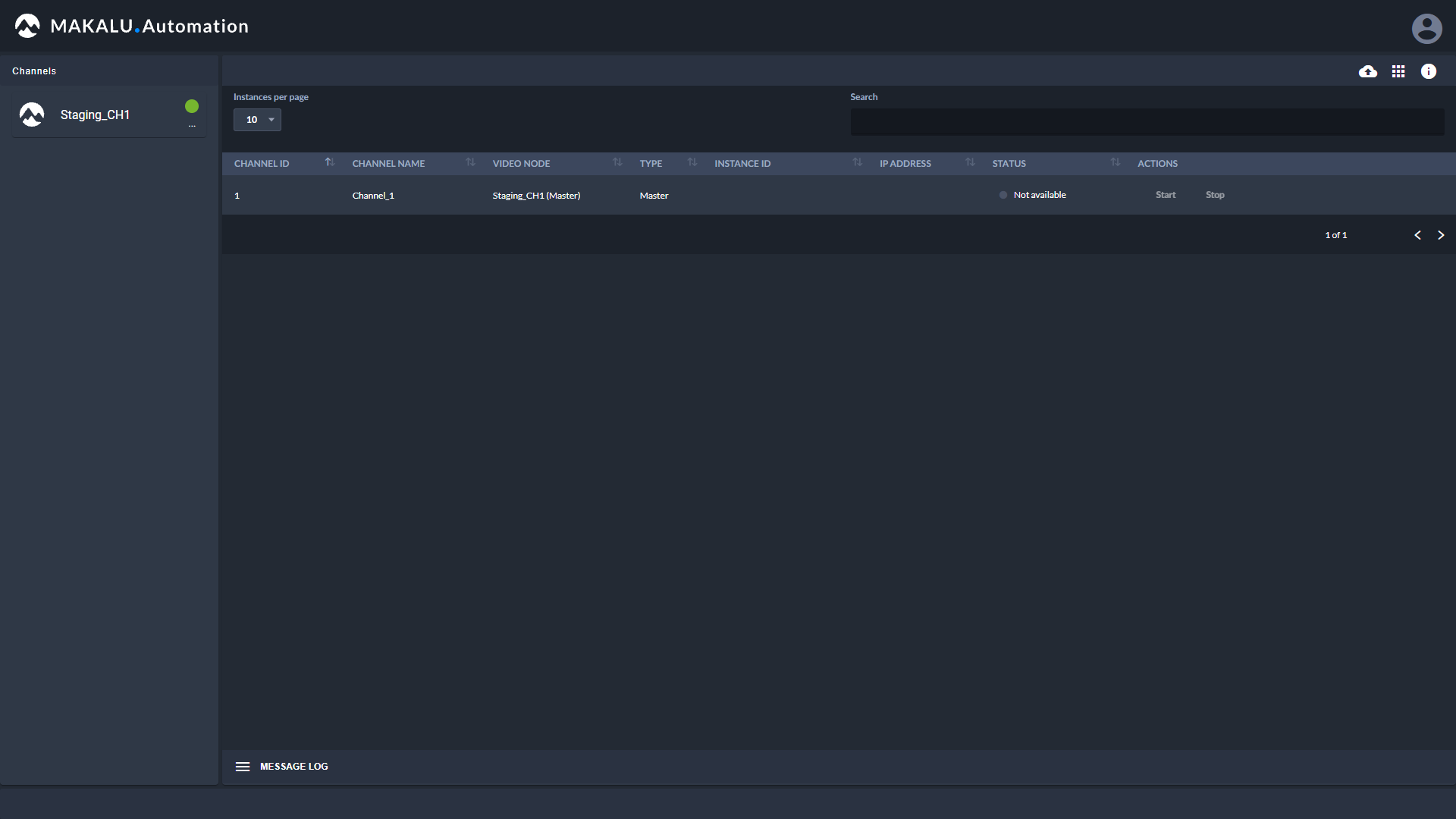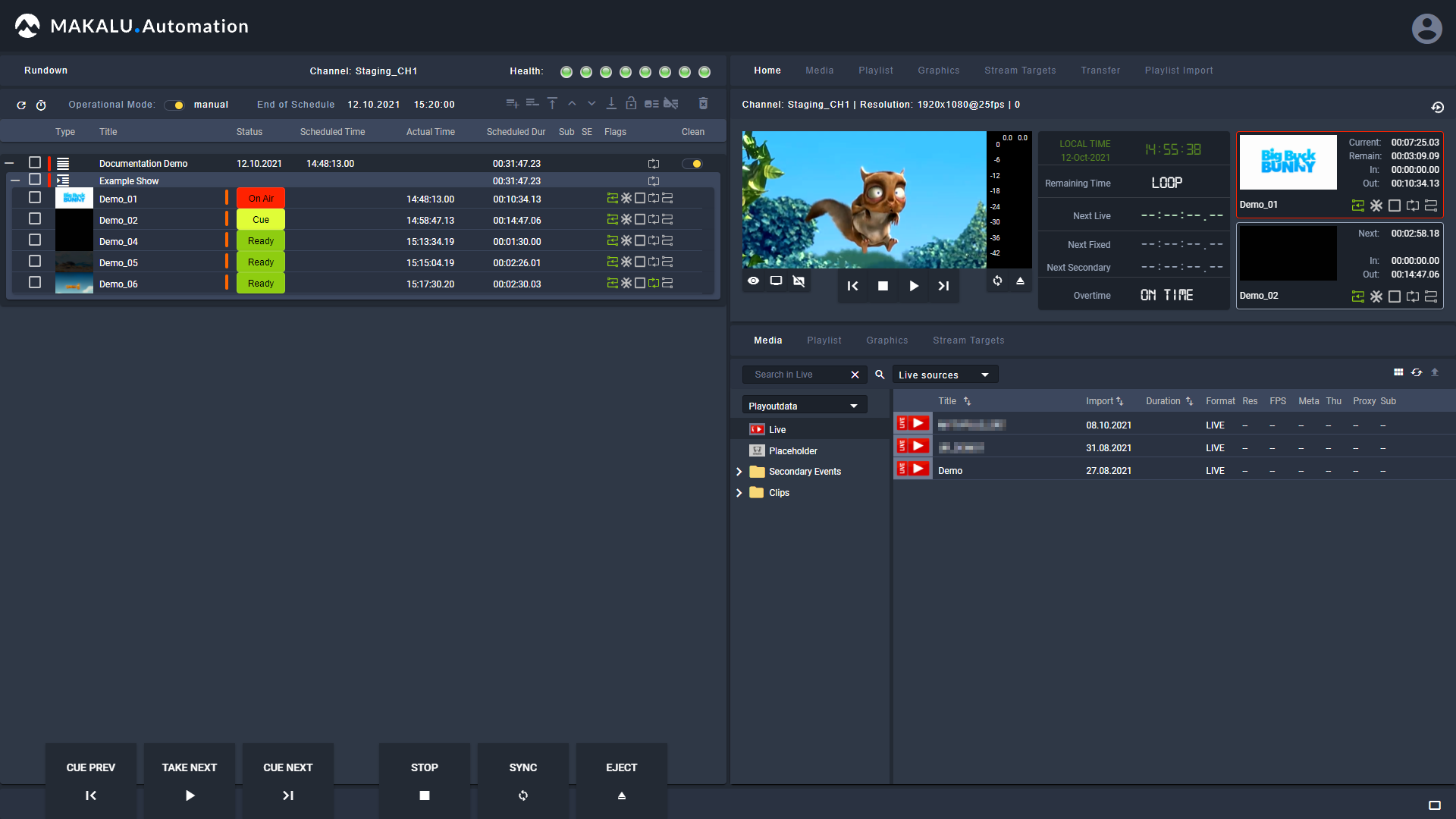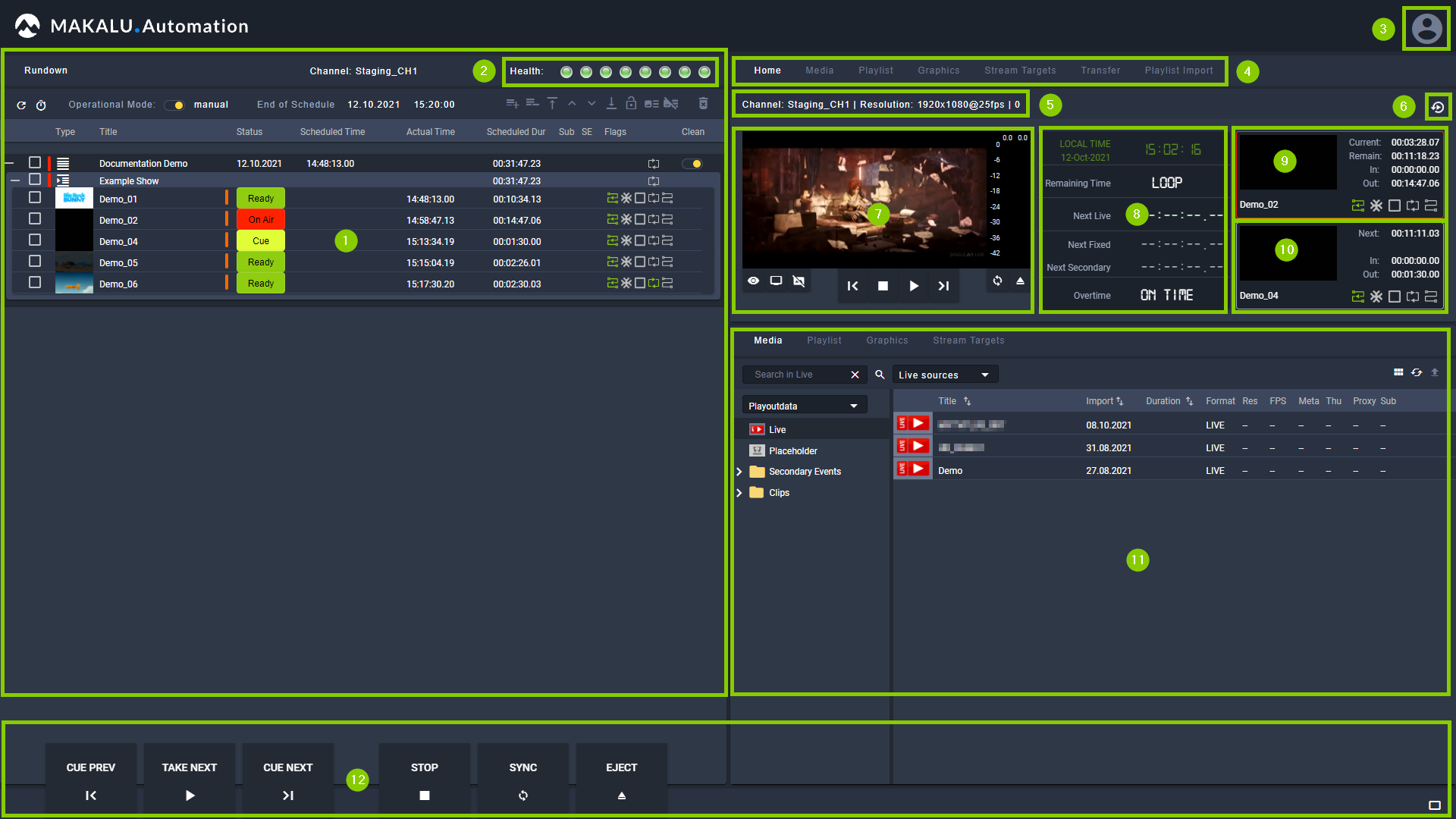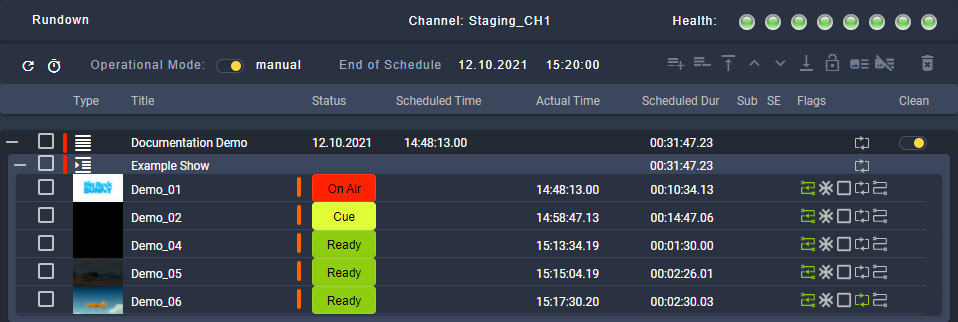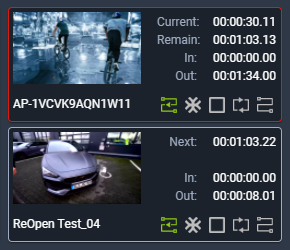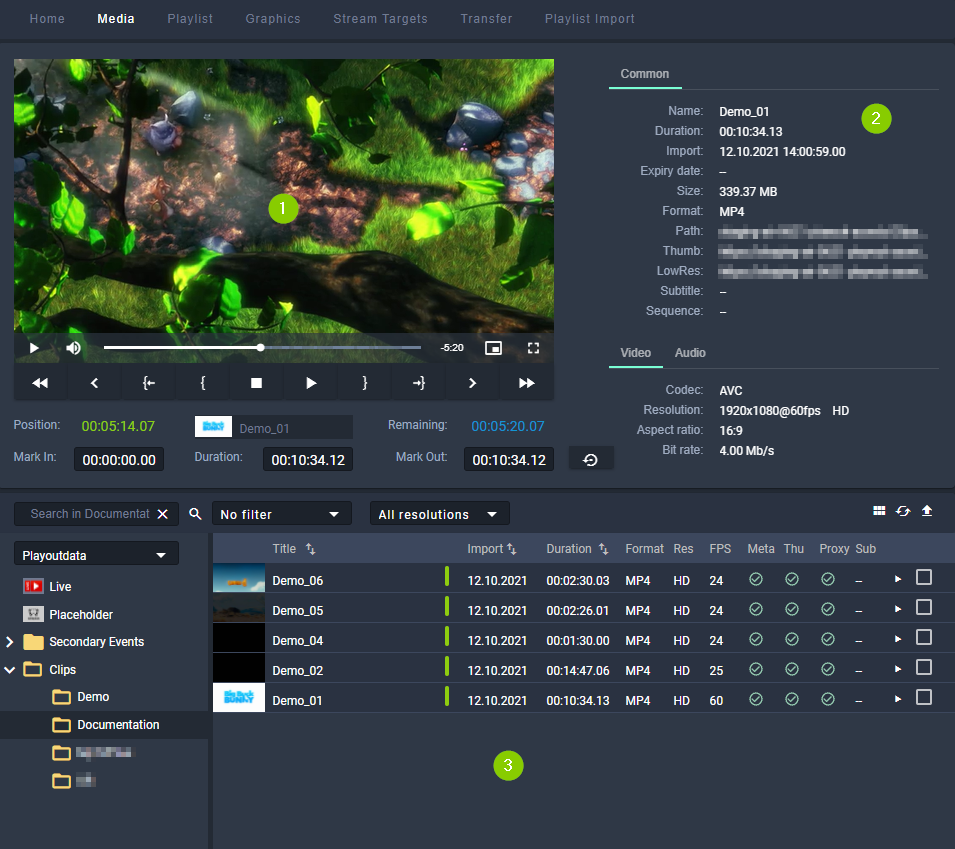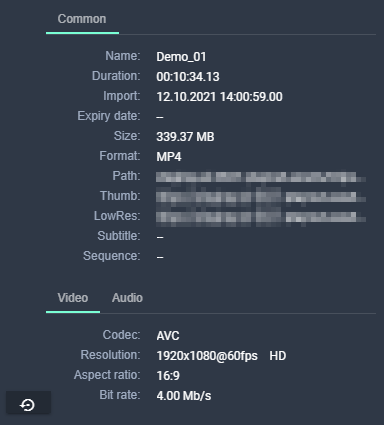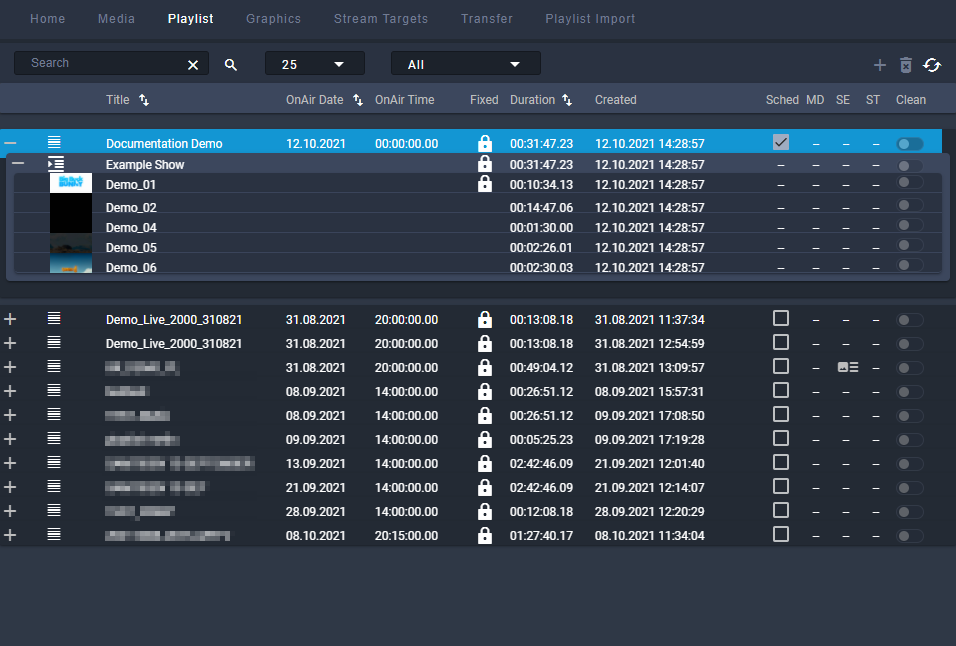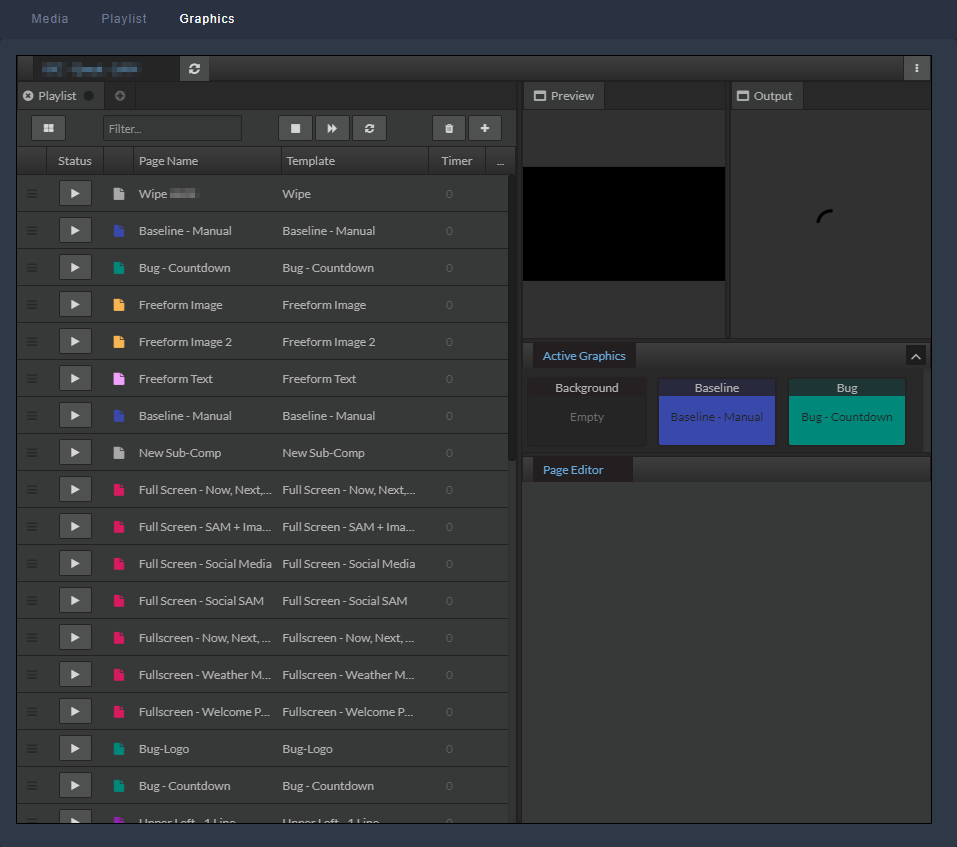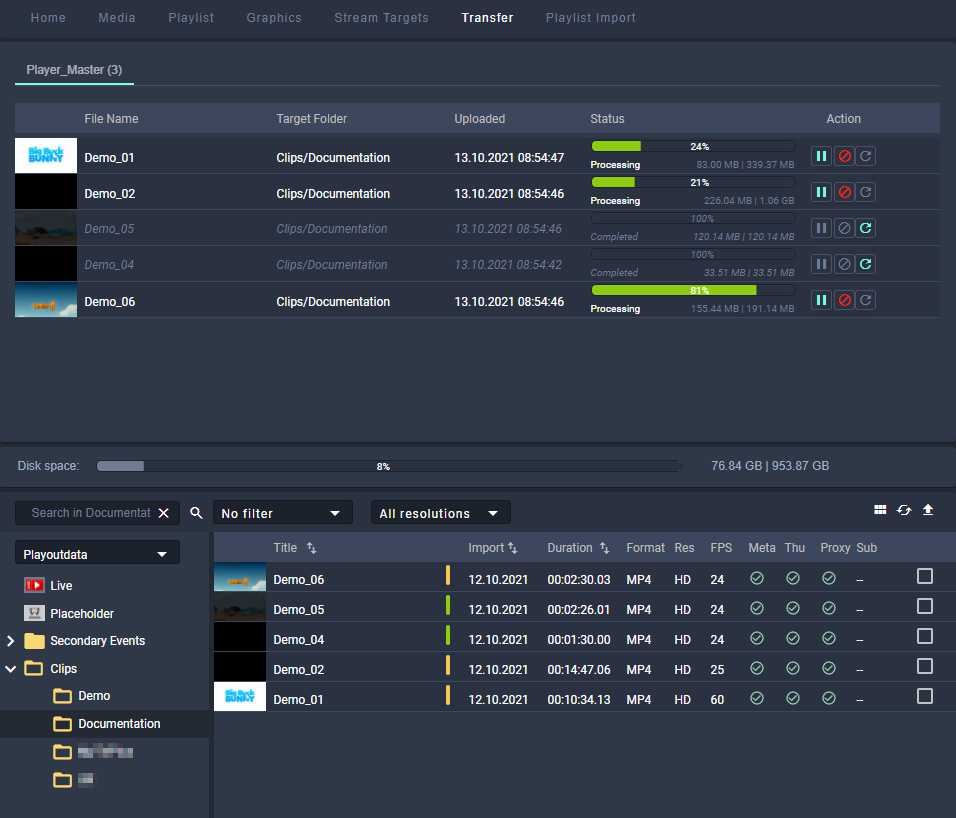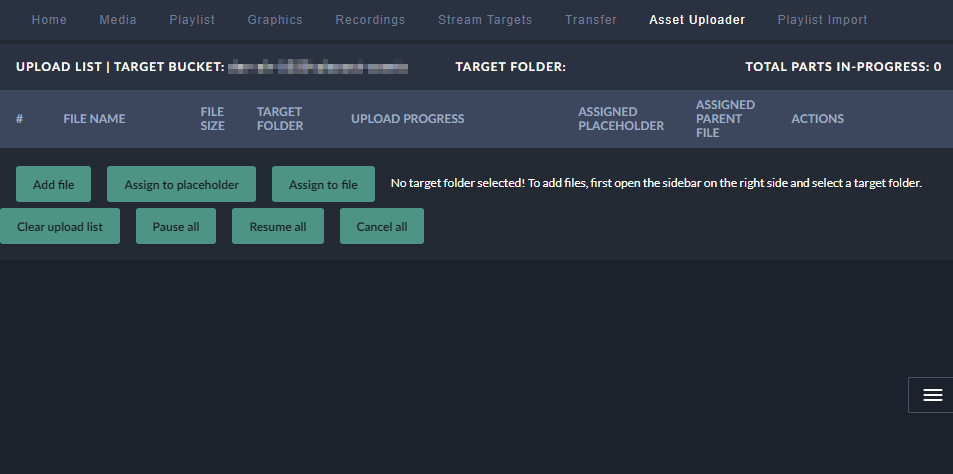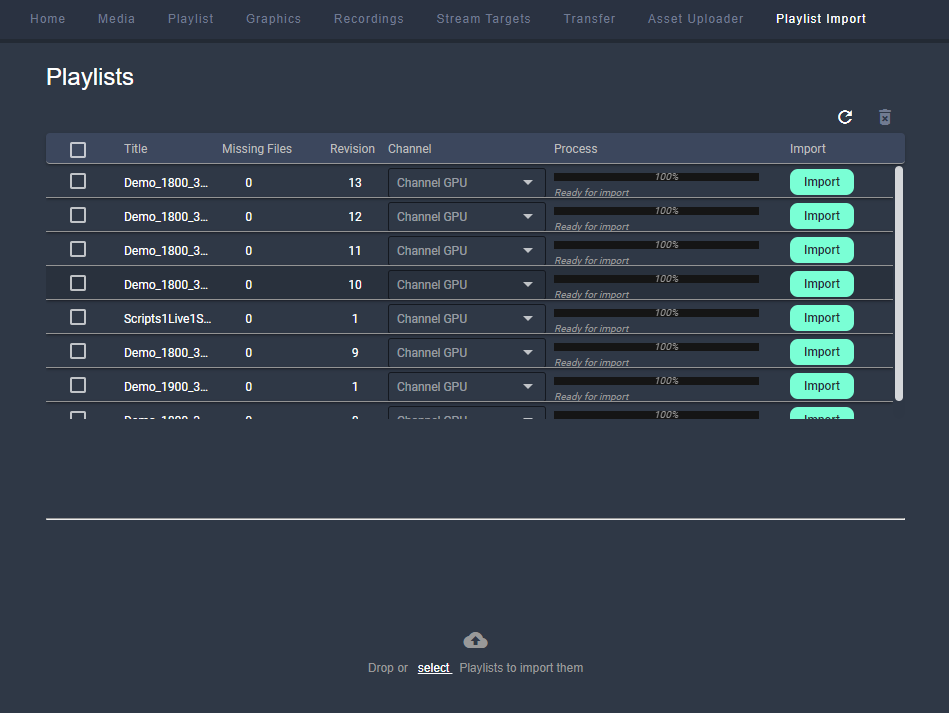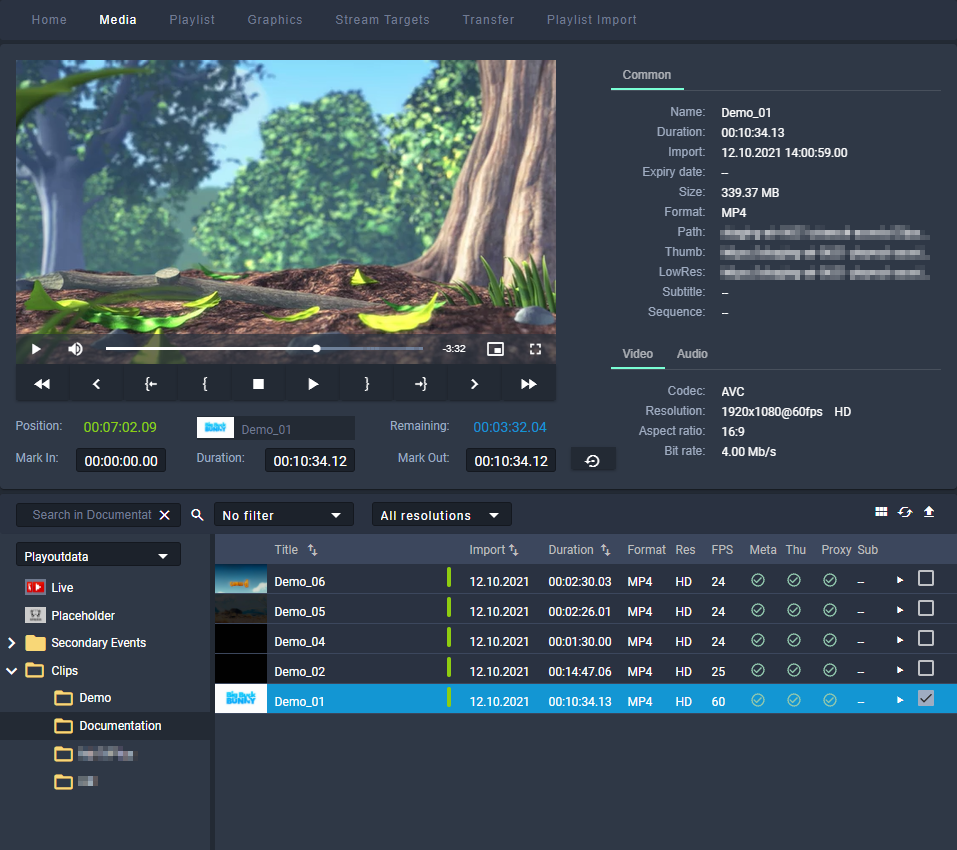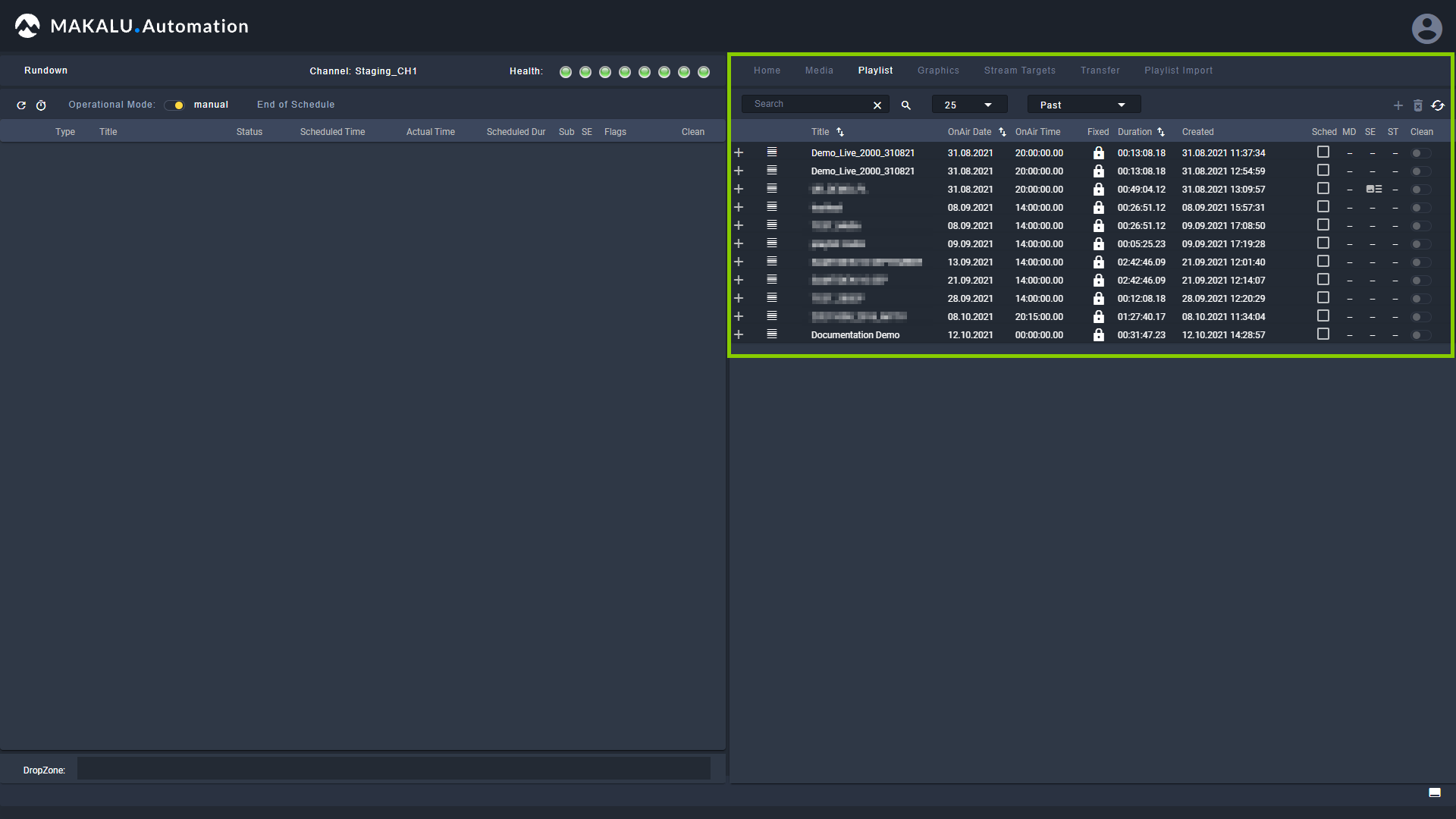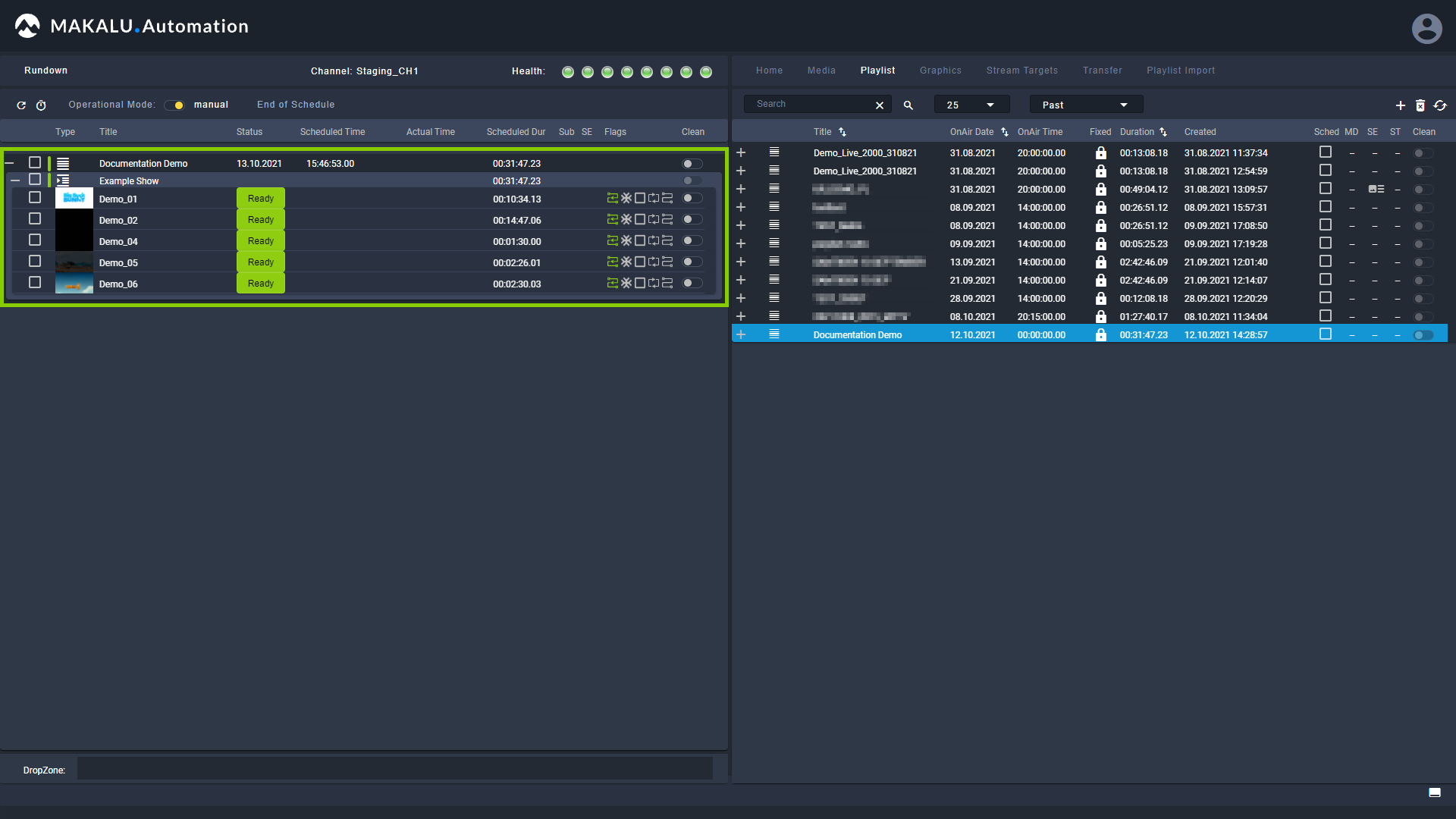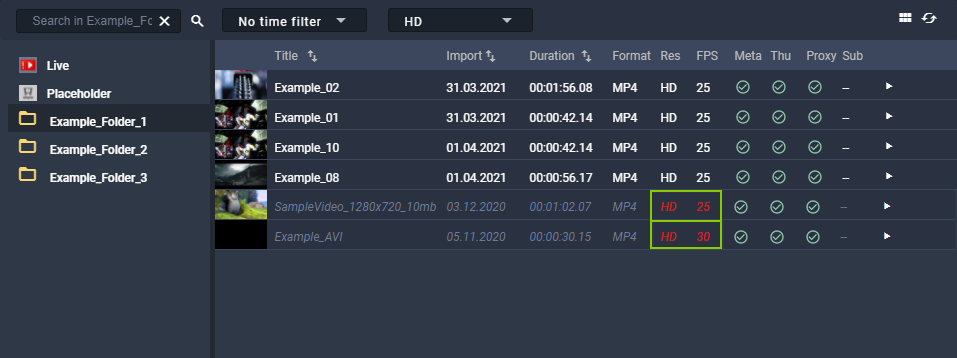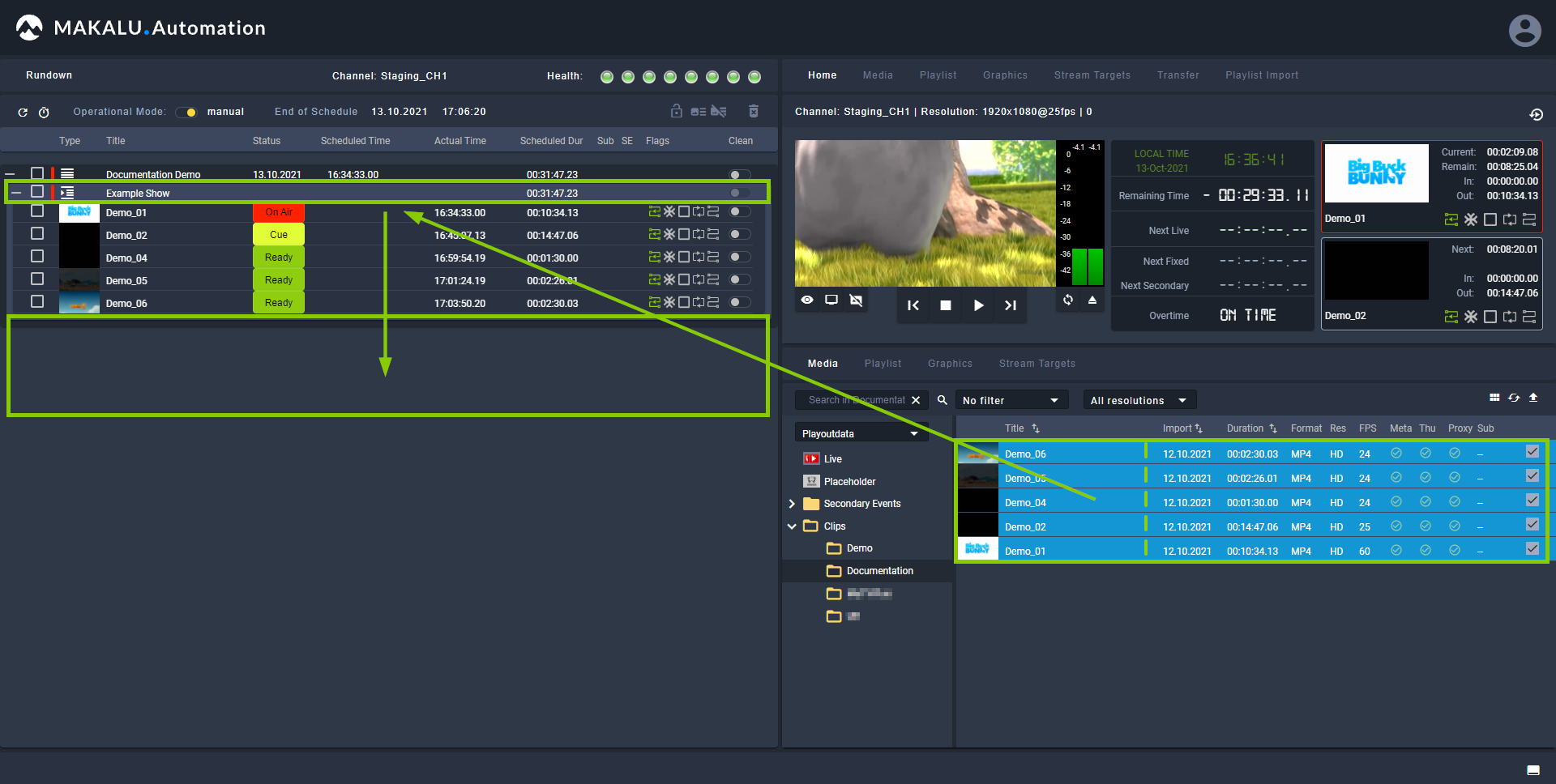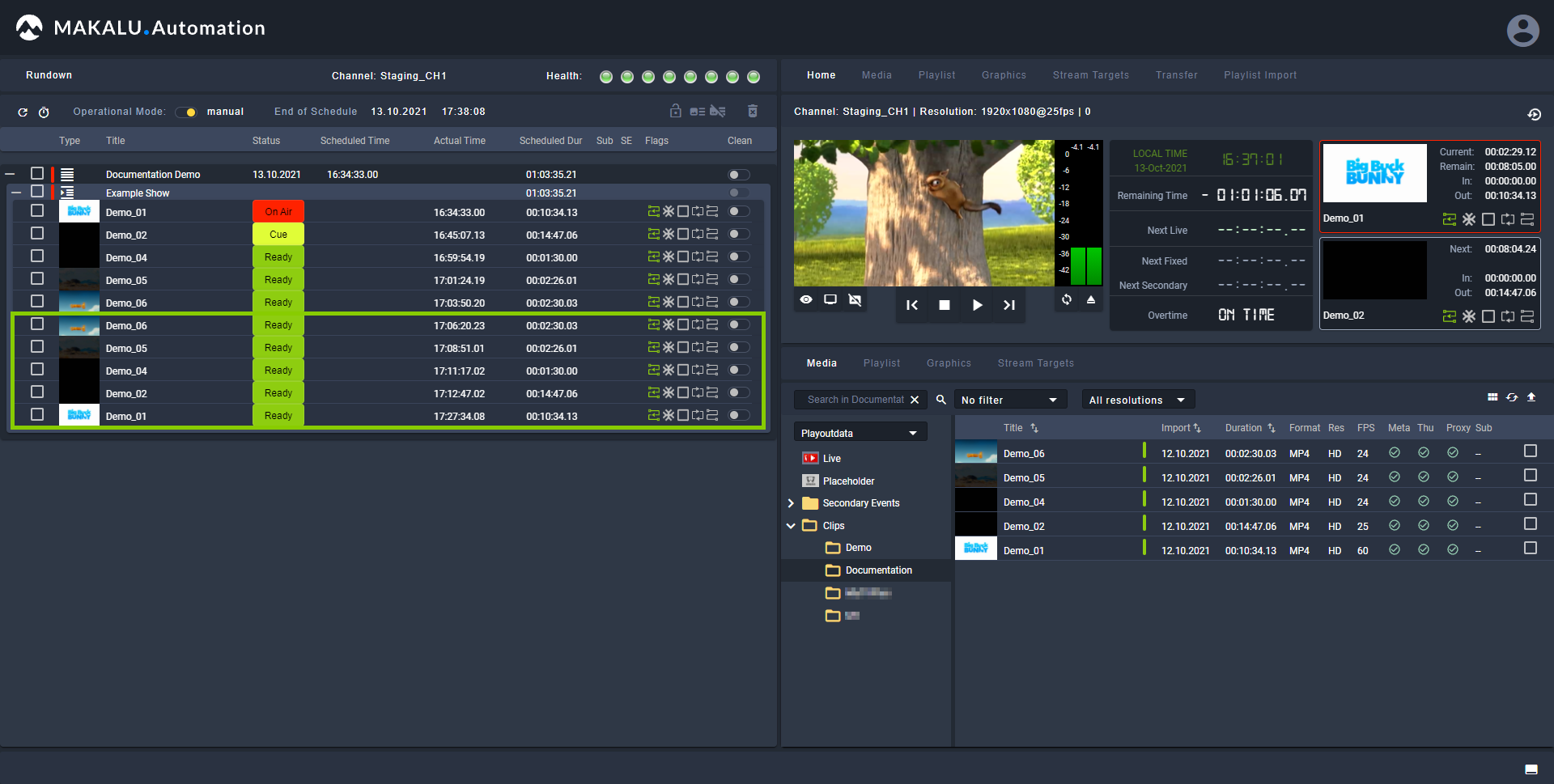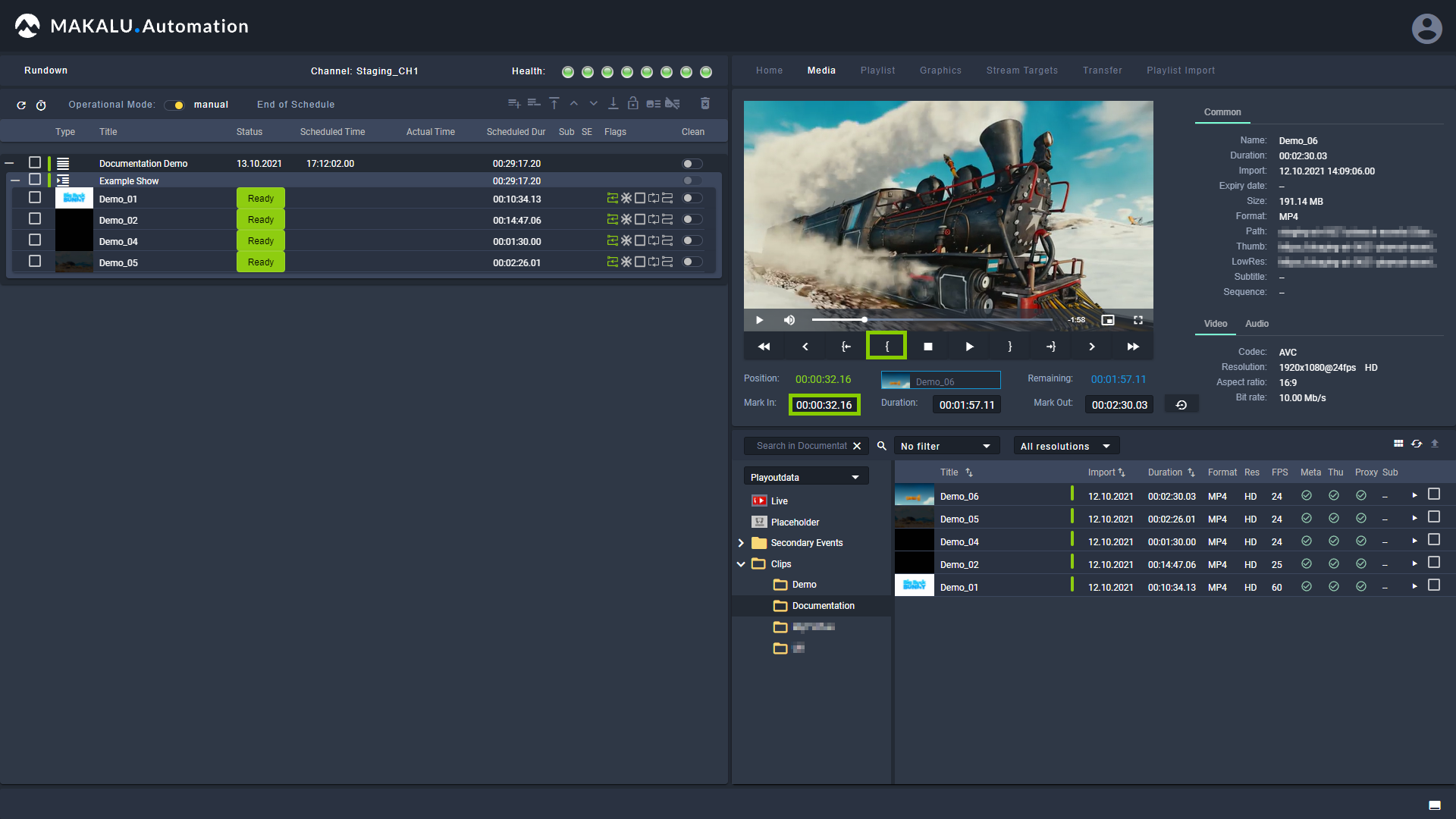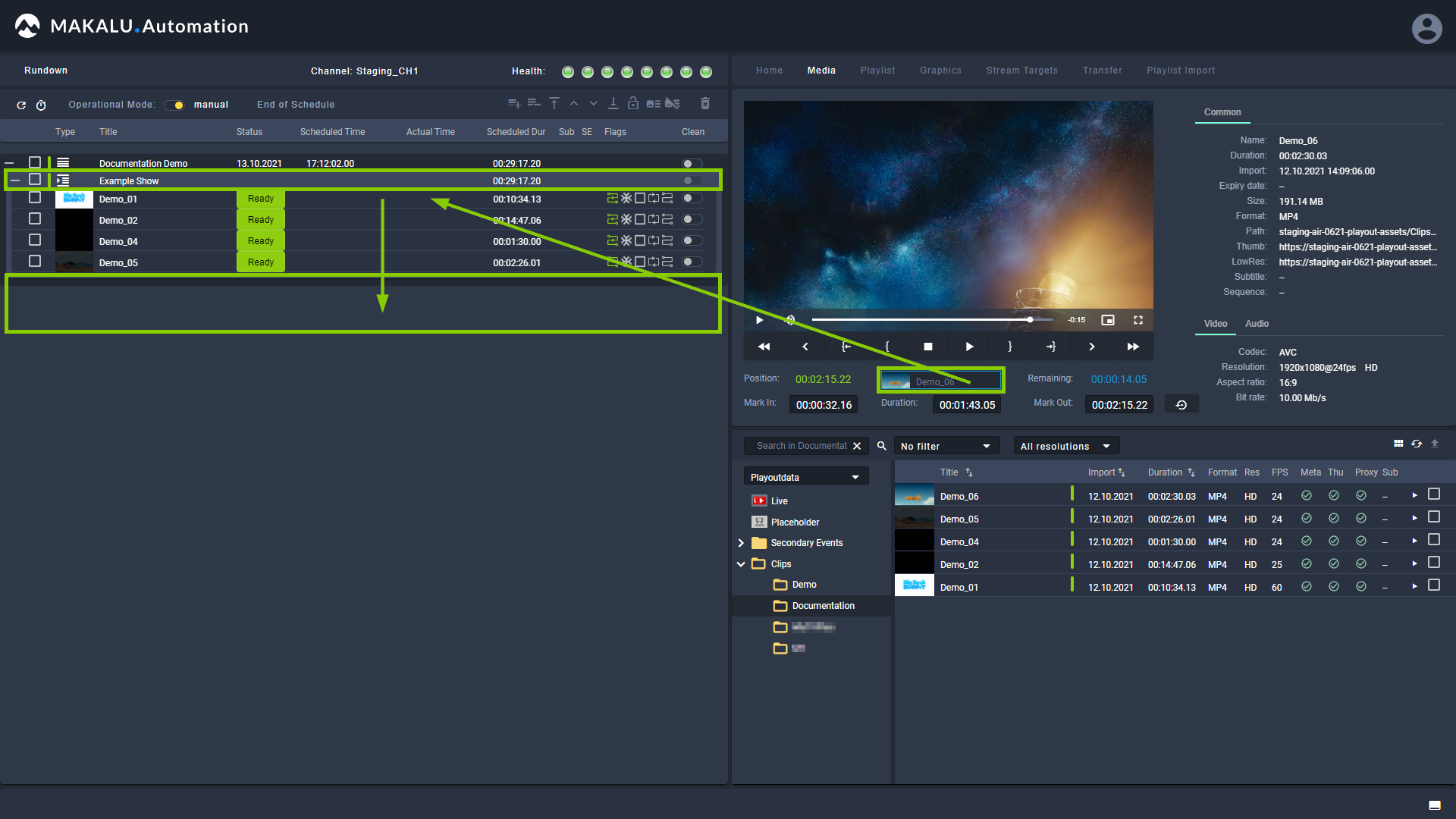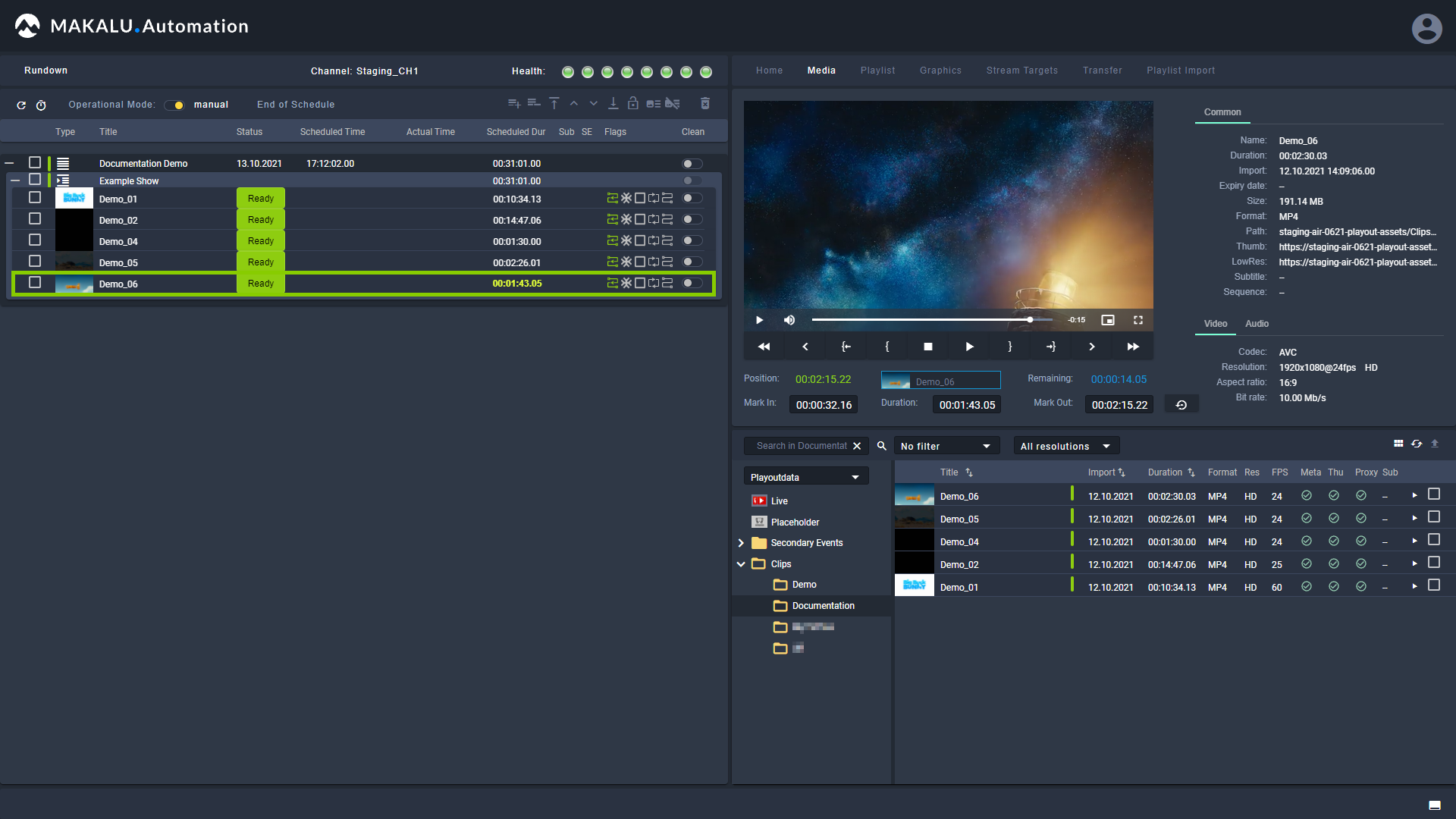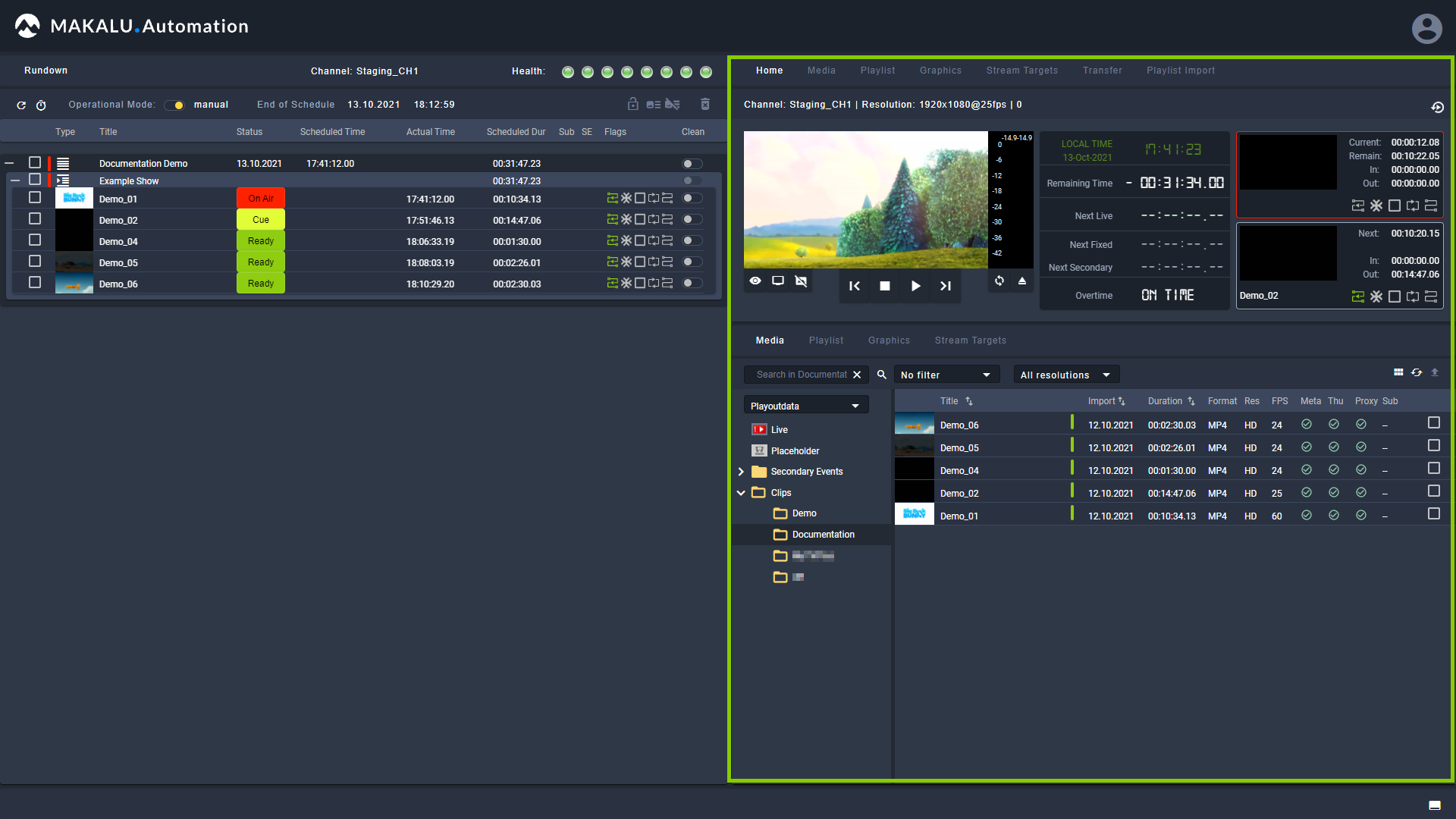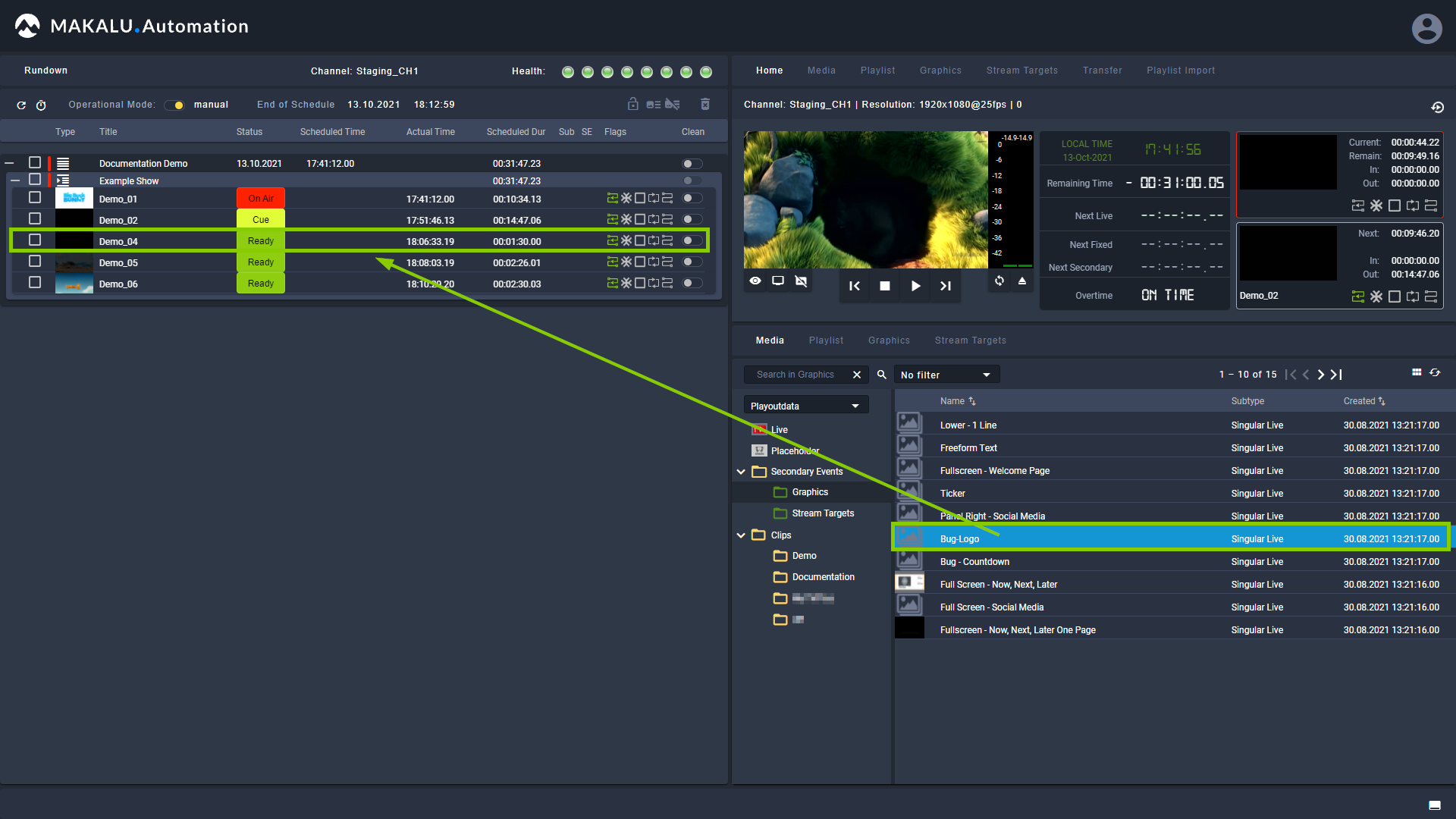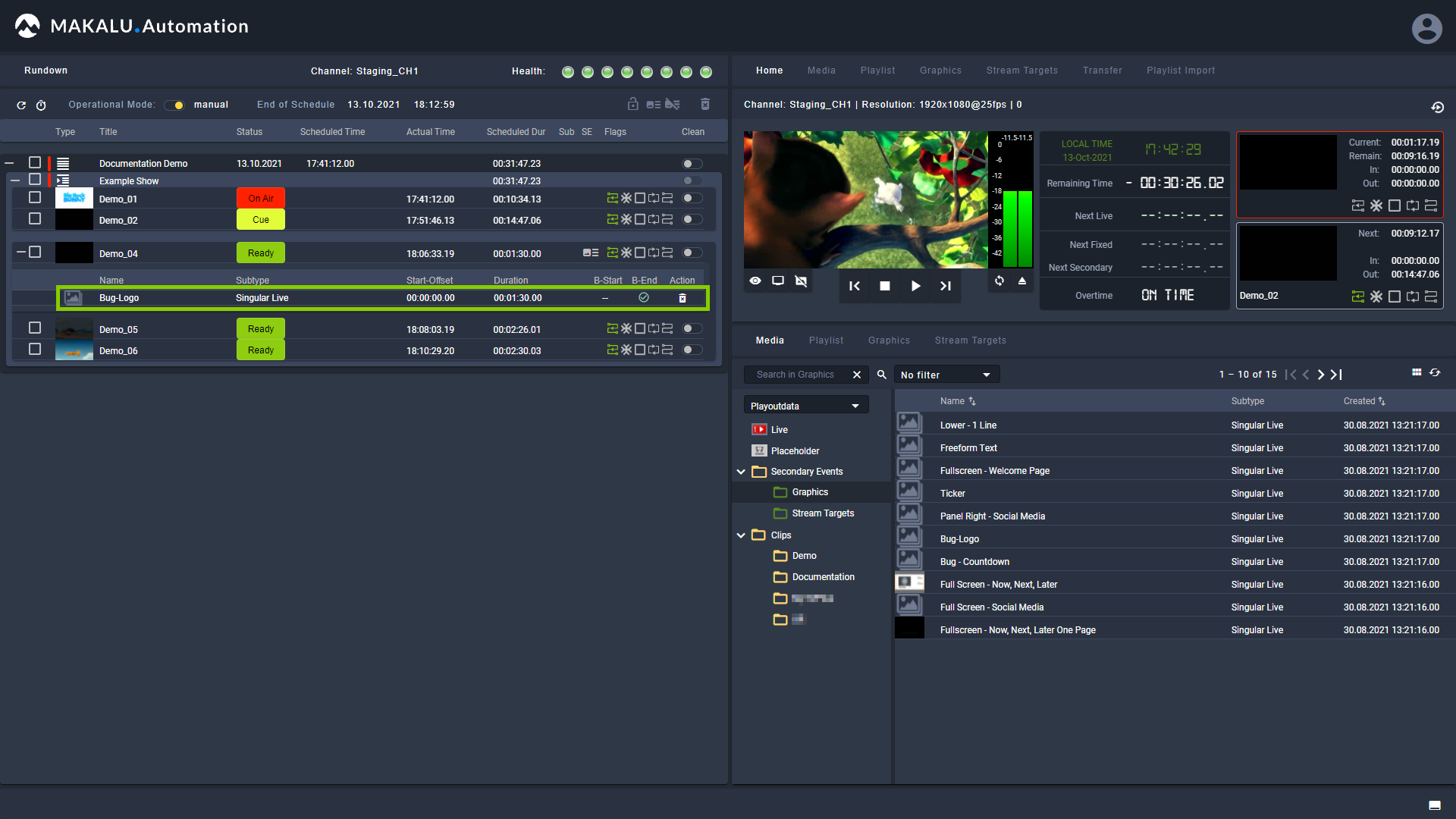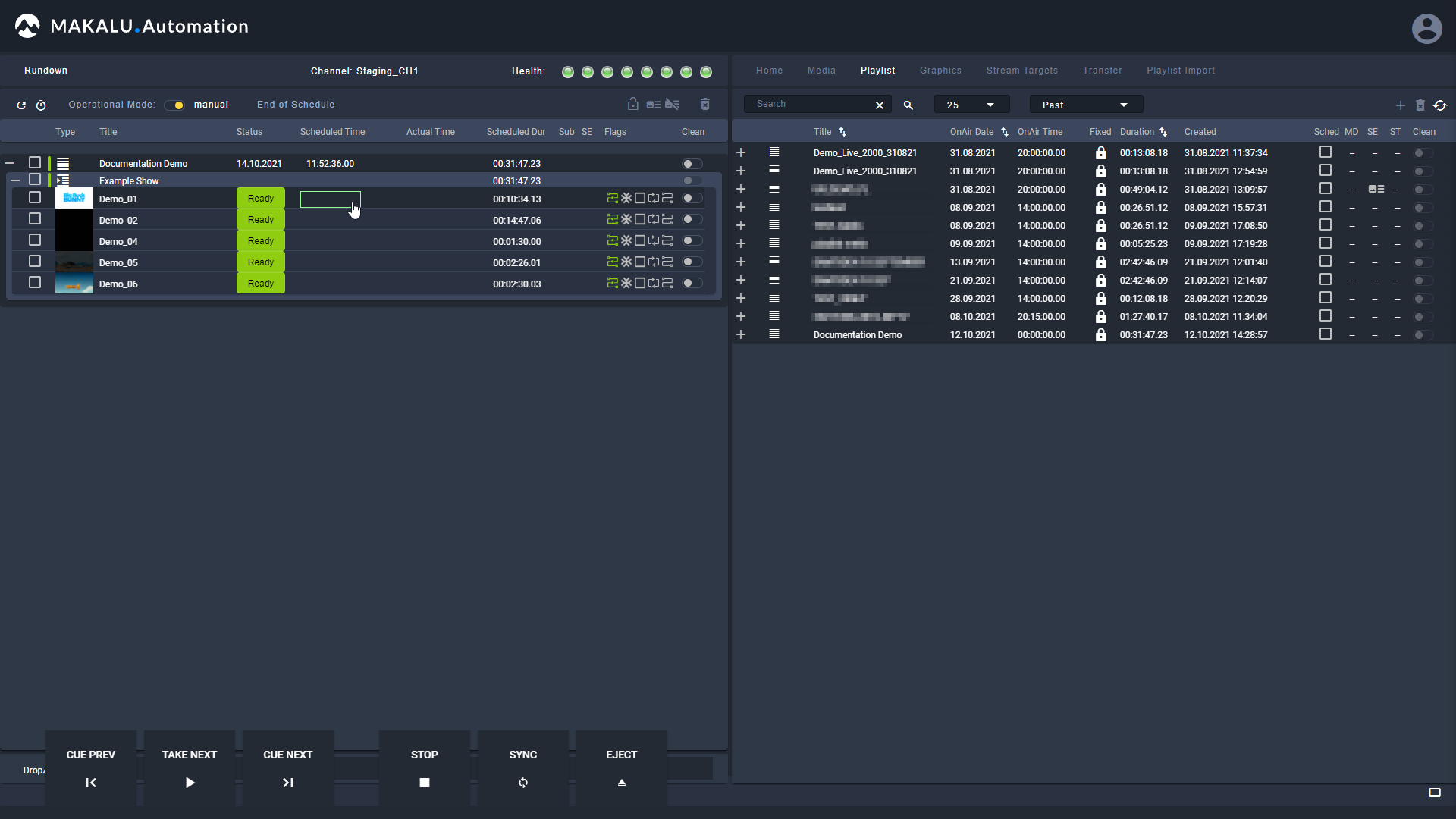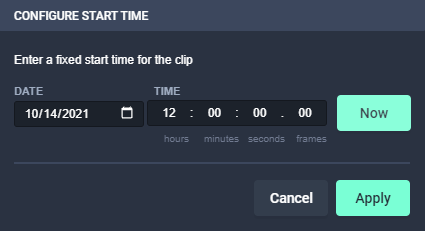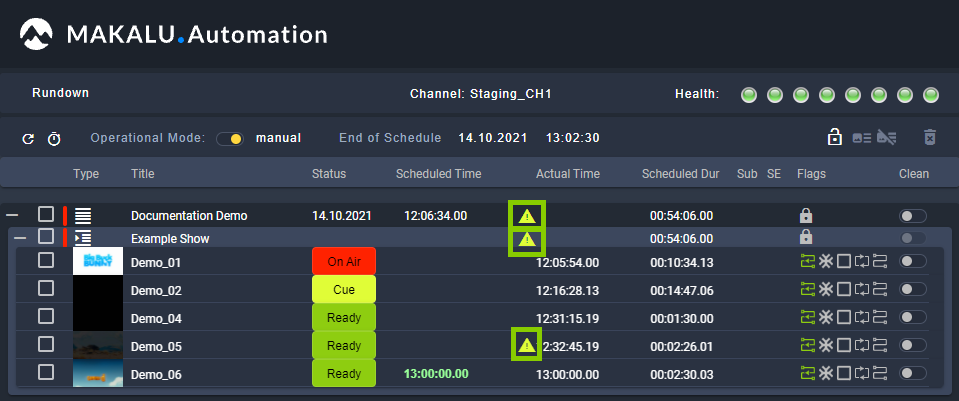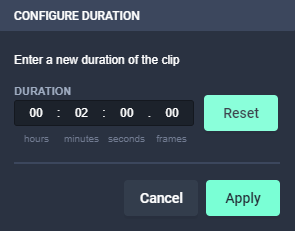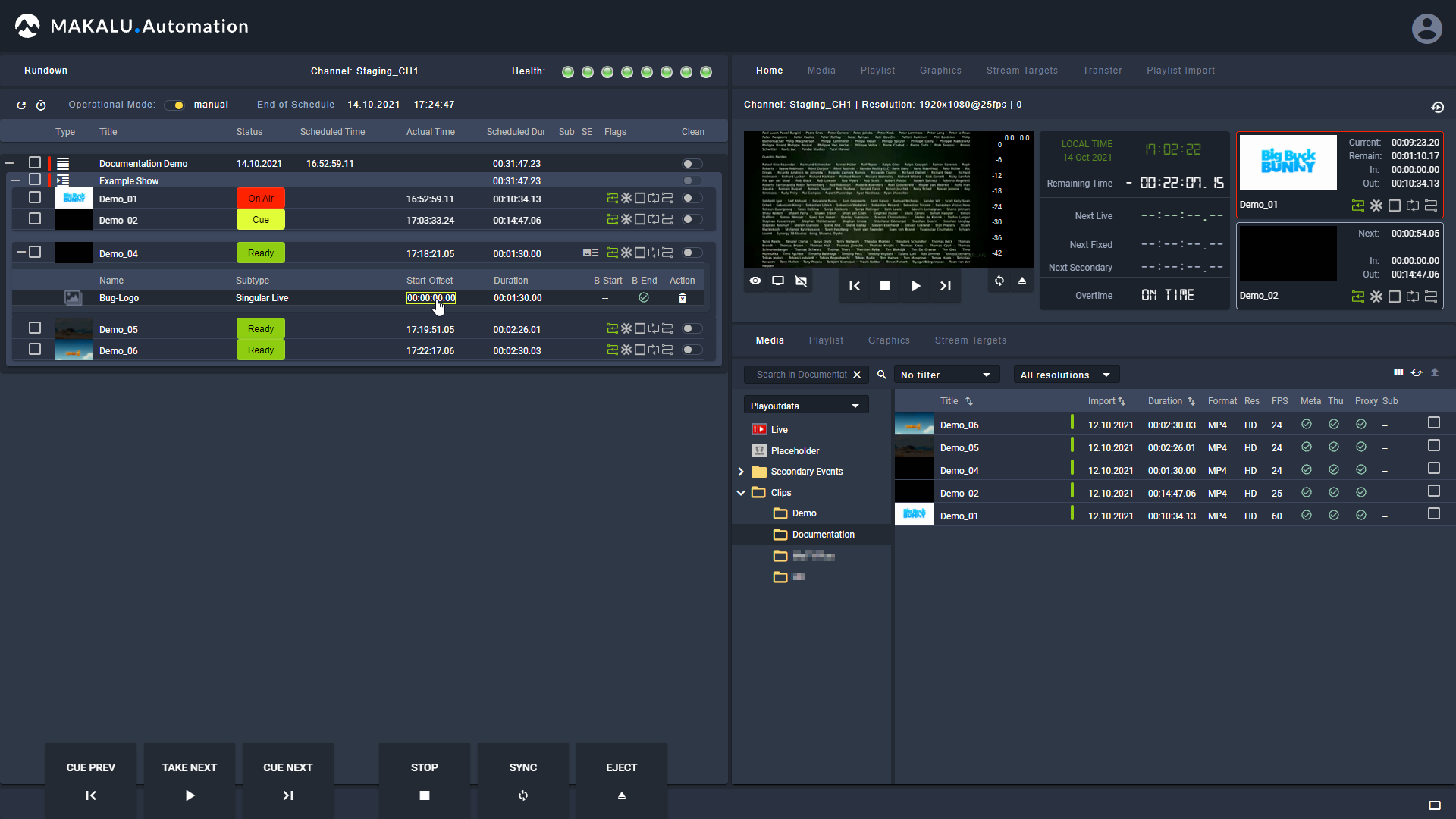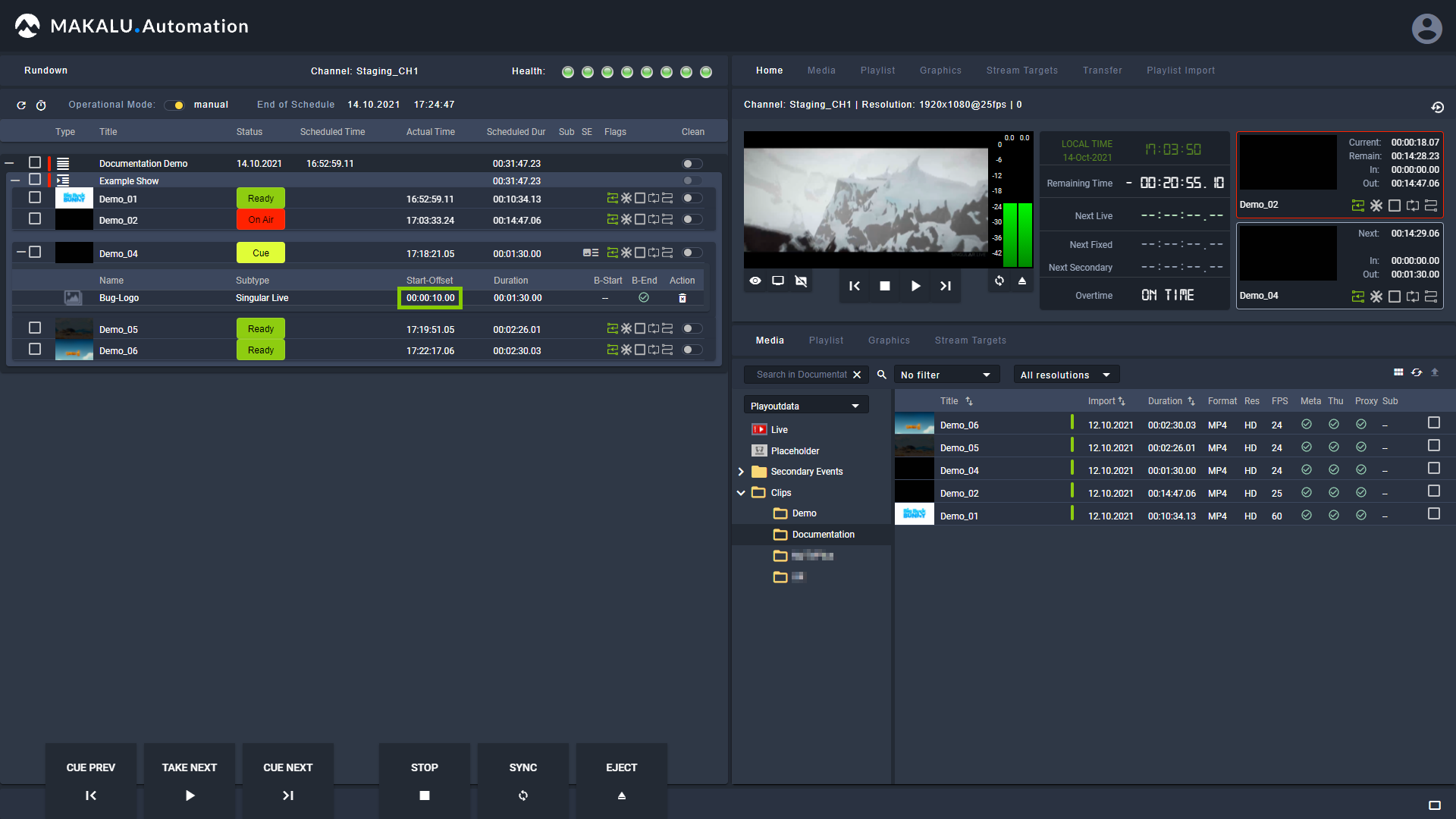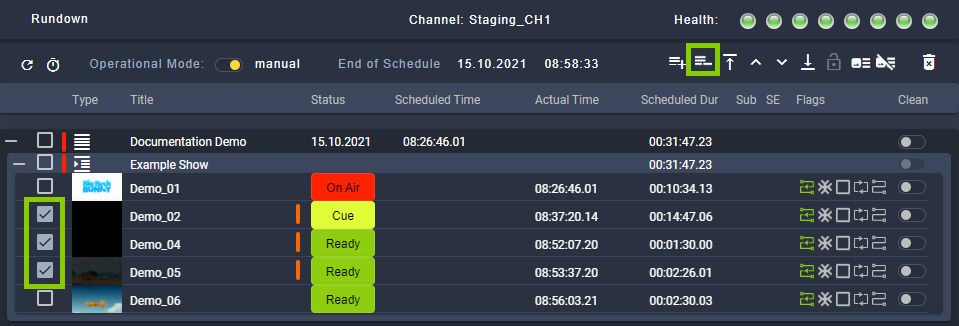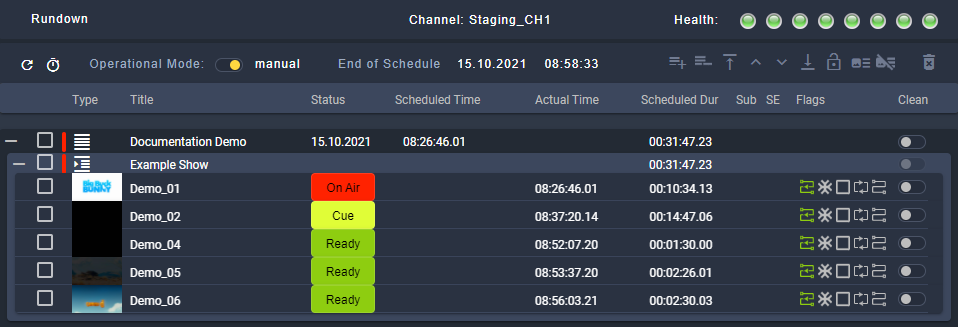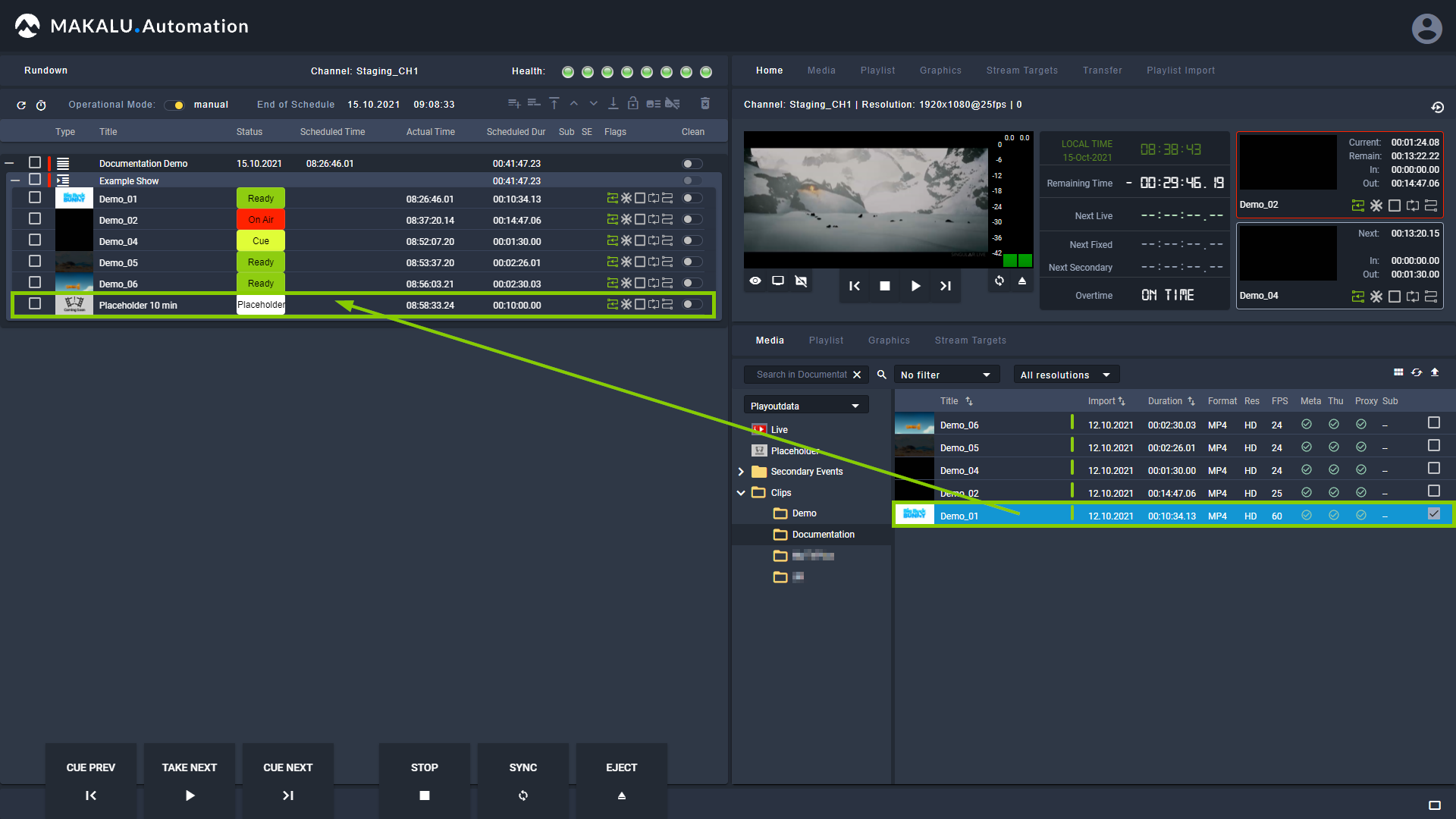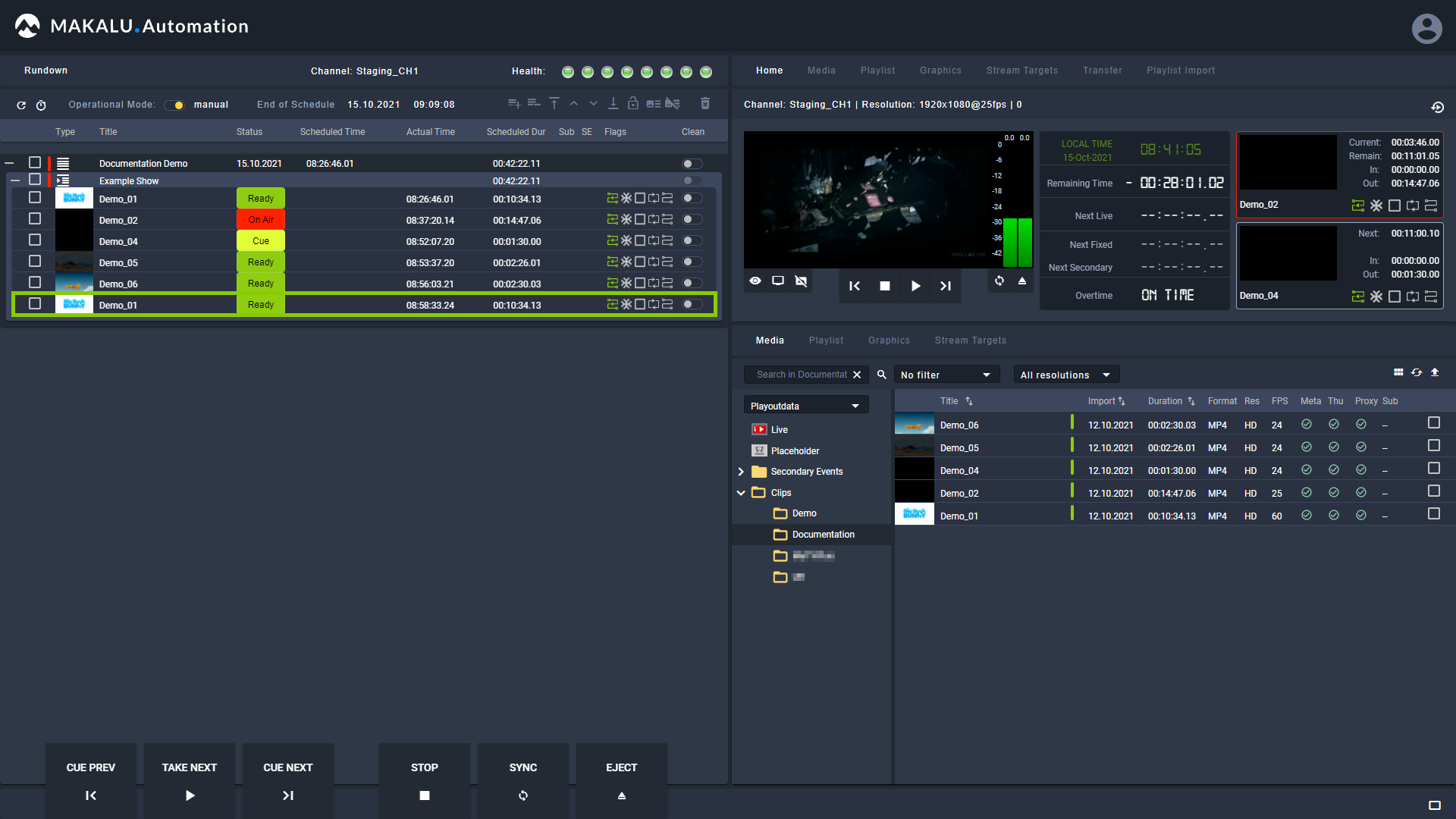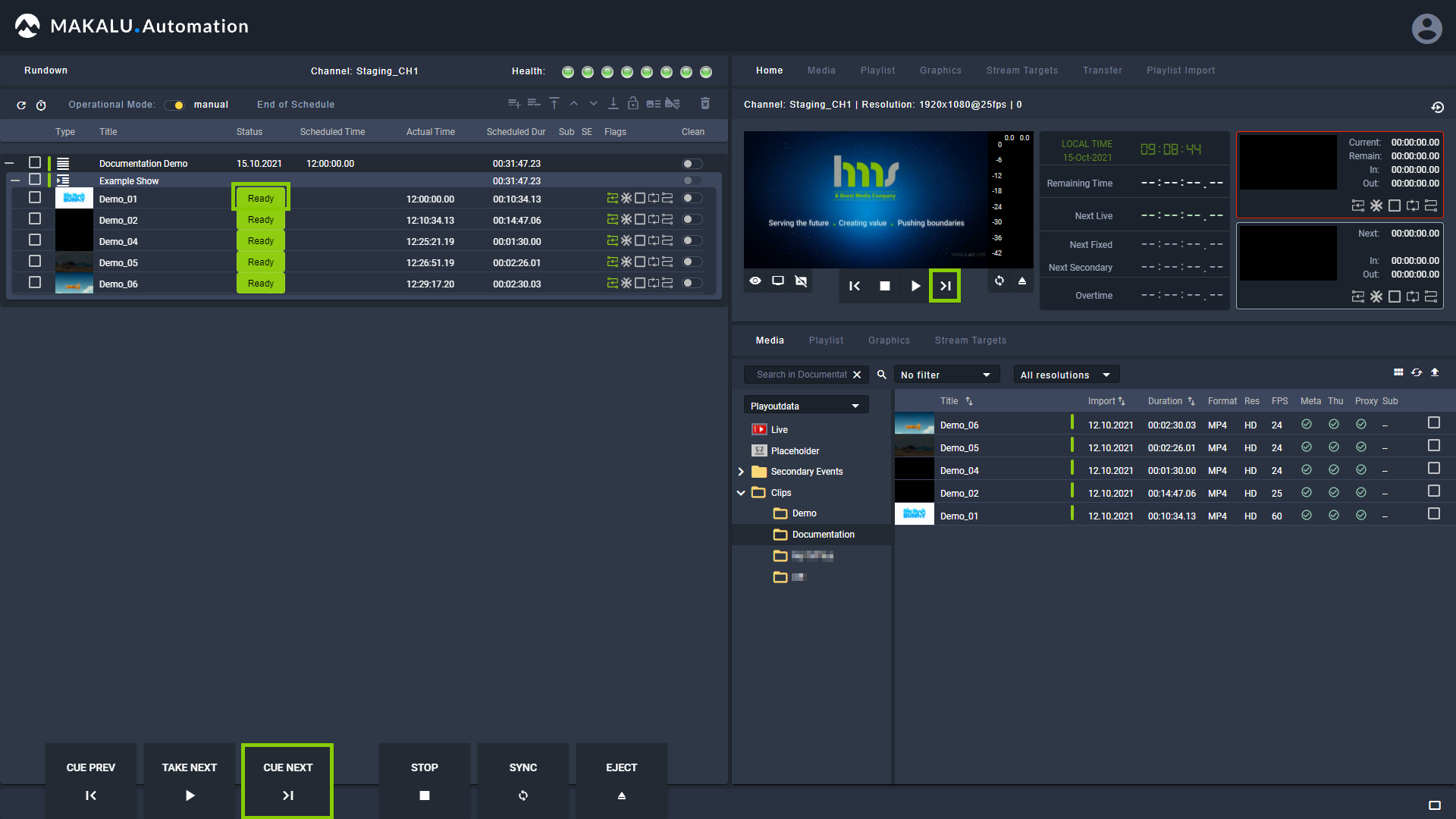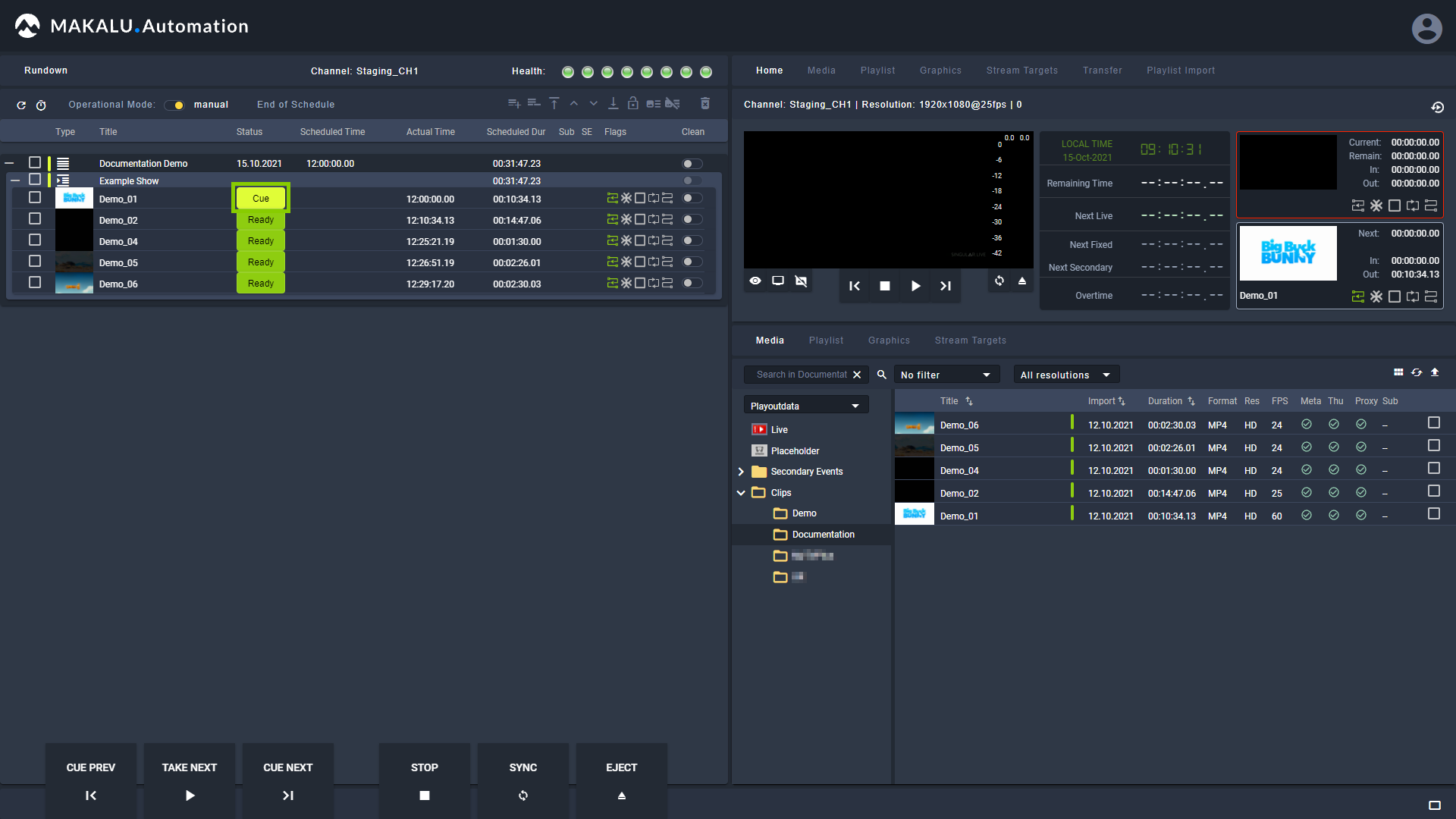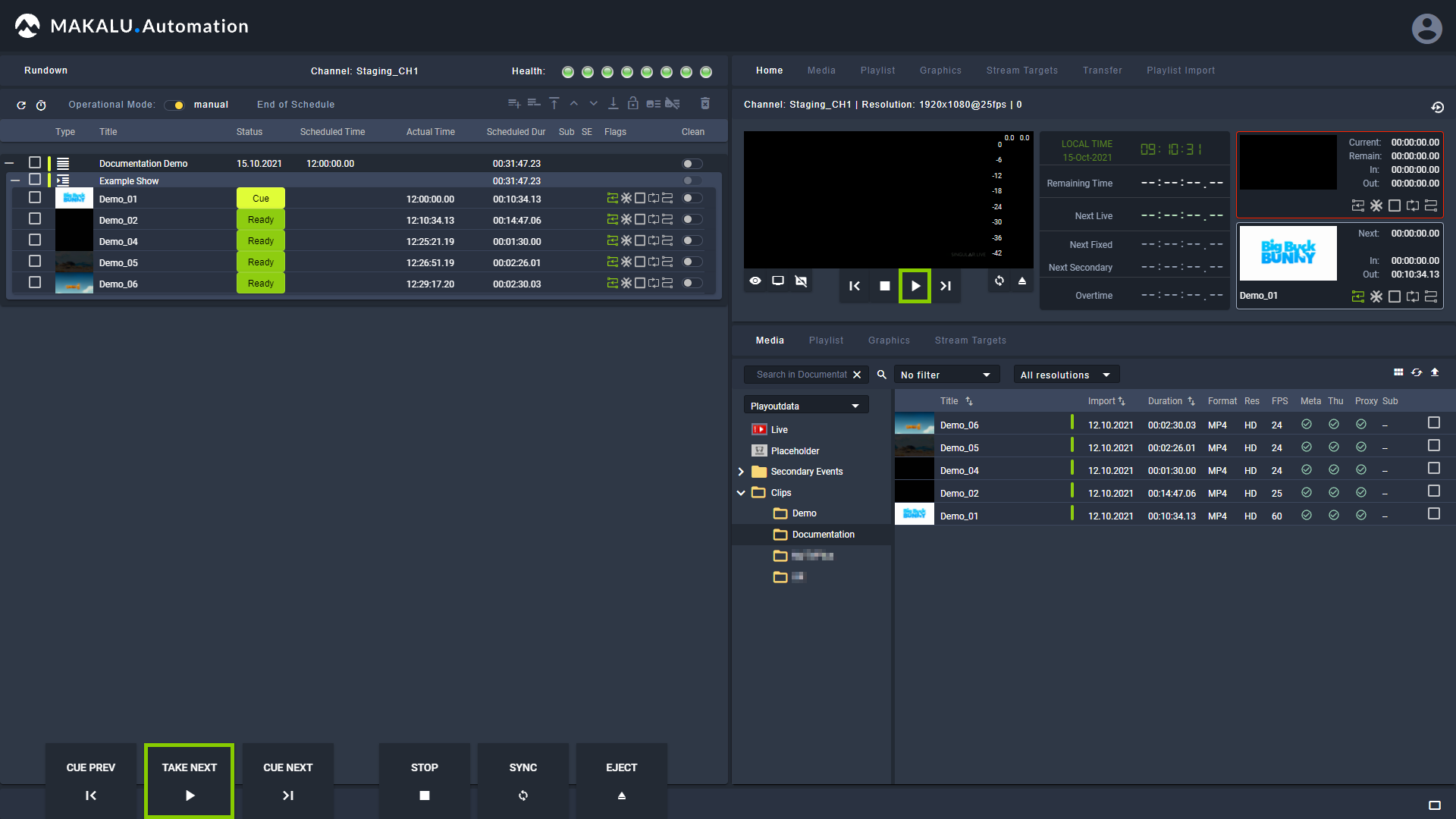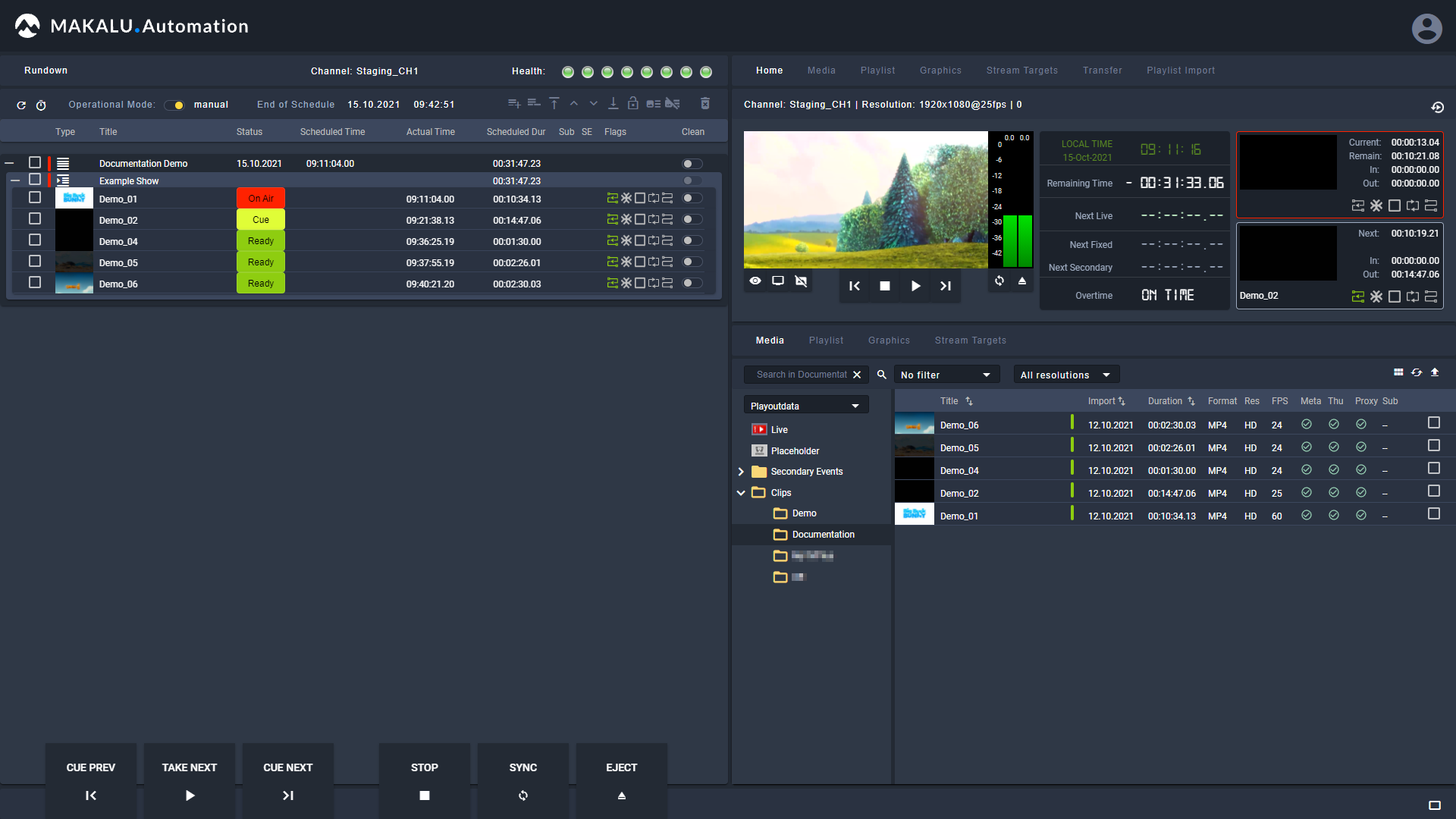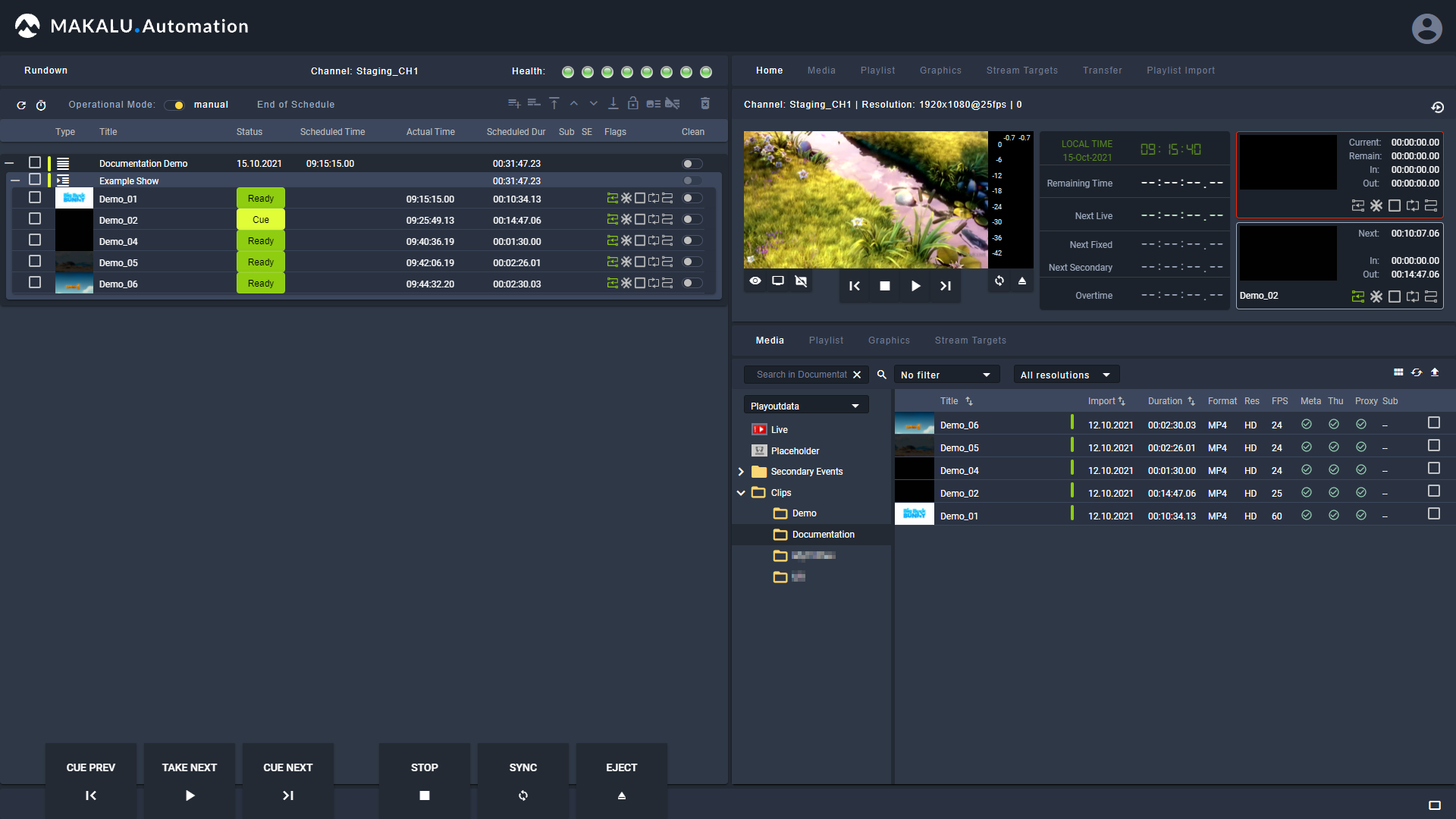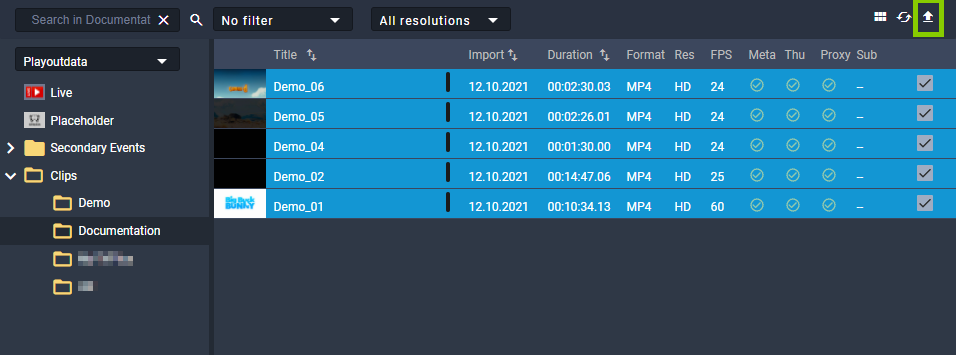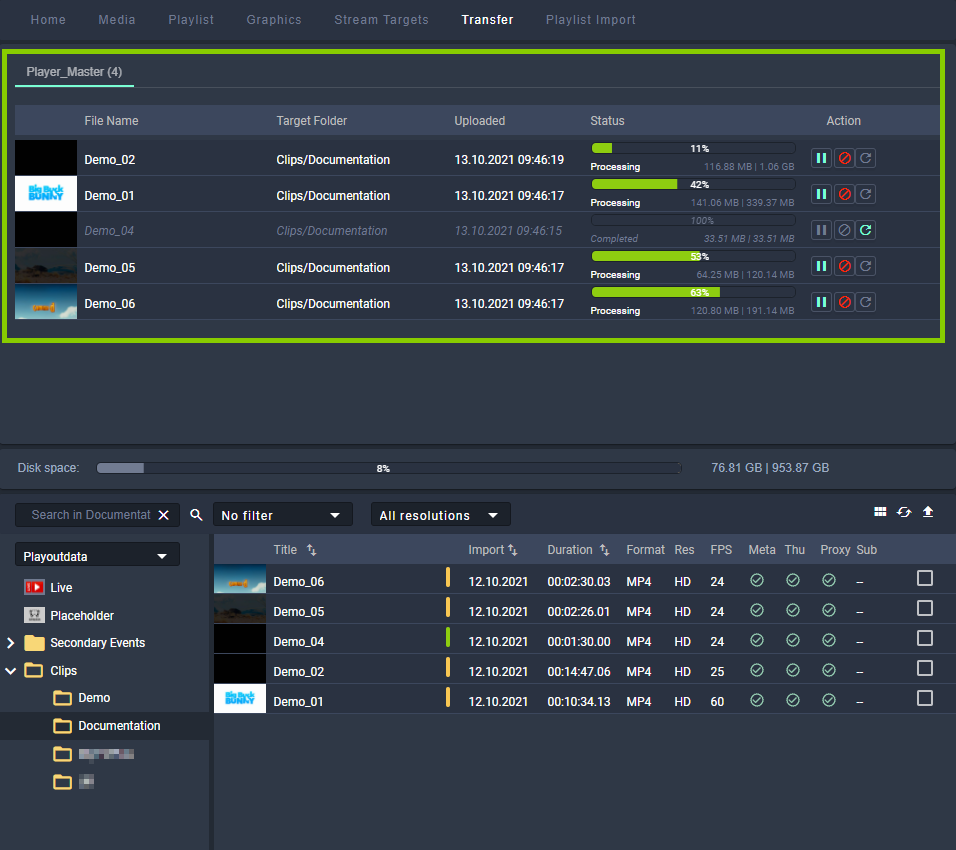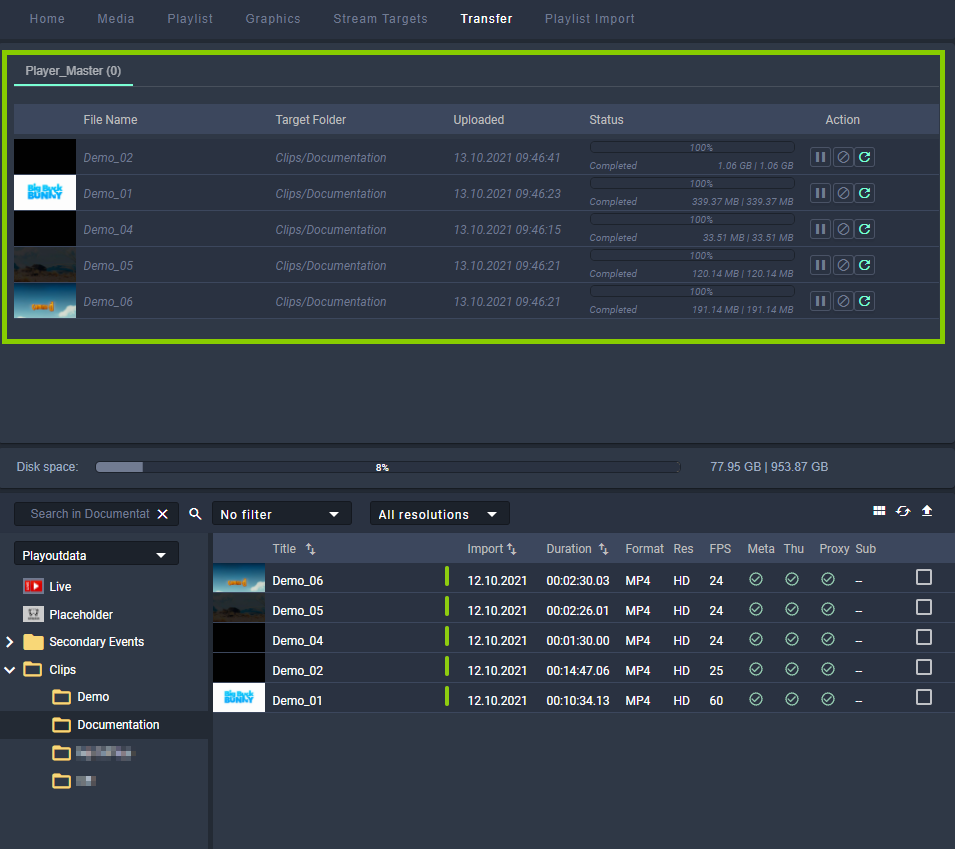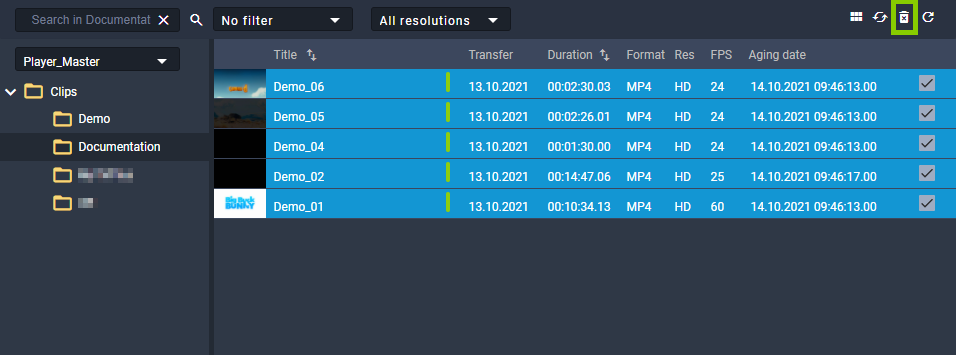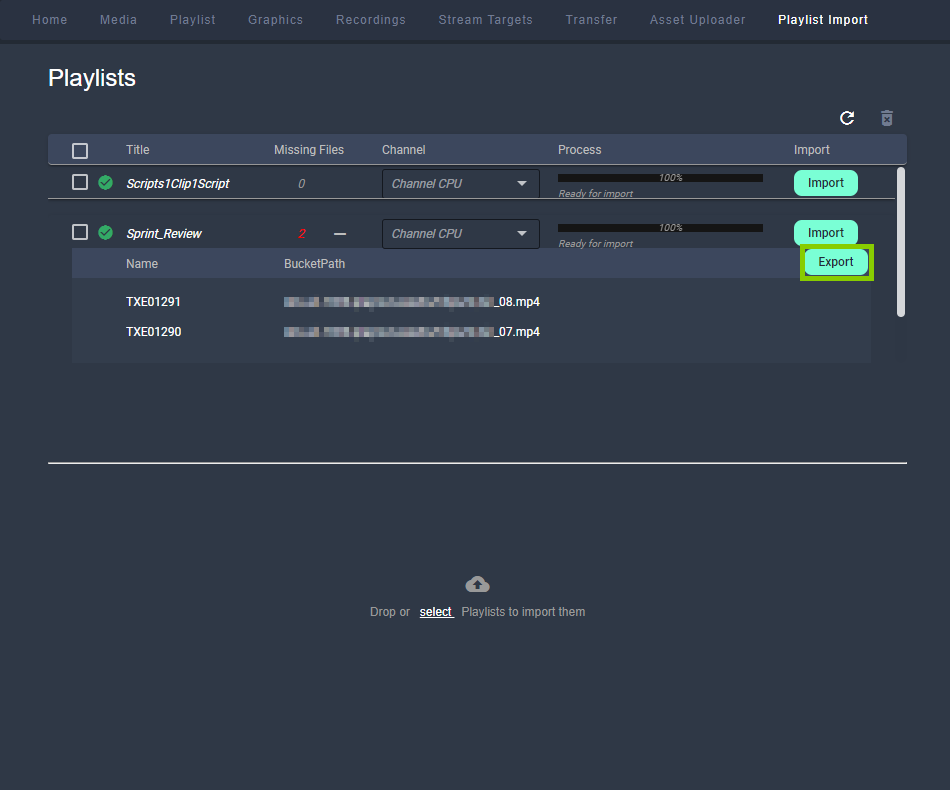Automation¶
Makalu Automation is the user interface for manually controlling the Makalu playout automation. Depending on the number of playout channels, it includes one or more individually controllable players, running on playout instances.
Each player seamlessly plays the video content of a linear playout channel based on a rundown, that consists of playlists, shows, clips. The playlists are created via the Makalu Traffic planning component.
Accessing Makalu Automation¶
-
Open Makalu Automation via
https://automation.customer-identifier.makalu.live.The channel status overview is opened.
Figure: Makalu Automation - Channel status overview
-
In the Channels sidebar on the left select a channel.
Notice
You can only select channels that are online. Online channels are highlighted with a green circle icon. Offline channels are highlighted with a red circle icon.
The Makalu Automation user interface for the selected channel is opened.
Figure: Makalu Automation user interface
Tip
From the Makalu Automation user interface, you can go back to the channel status overview, by clicking the white Makalu logo in the top left corner.
Starting and stopping a channel¶
Notice
Each playout instance can be started or stopped individually when deployed on AWS.
Warning
If you stop a channel, the corresponding playout instance is shut down and distribution targets configured for this channel will not receive any content.
In Makalu Automation each playout instance can individually be started or stopped. To do this, open the channel status overview like described in section Accessing Makalu Automation and proceed as follows:
To start a playout instance, in the status list click Start for the channel to be started.
To stop a playout instance, in the status list click Stop for the channel to be stopped.
Makalu Automation user interface overview¶
The main user interface consists of the following elements:
Figure: Makalu Automation user interface
-
Channel rundown
-
Channel health indicators
-
User account settings
-
Navigation tabs for accessing the "Home" area, media assets, playlists, graphics, recordings, stream targets, file transfers, Asset Uploader and playlist import
-
Channel information (channel name, resolution, framerate, and number of currently displayed graphics)
-
Restart player trigger
-
Channel preview including player controls and peak audio meter
-
Time-related rundown information
-
Information about the current clip
-
Information about the next clip
-
Media asset list (content varies depending on the selected navigation tab)
-
Rundown and player controls
Channel health¶
Figure: Channel health indicators
The health indicators display the current operating status of the most important internal system components (e.g. connection to backend components and player status).
To display the name of the corresponding component, hover over one of the indicators.
A green indicator means that the component runs normally, while a red indicator means that there was an error.
Channel rundown¶
Figure: Makalu Automation - Channel rundown
This area contains the rundown of the current channel. The rundown list contains all playlists, shows, and clips that are scheduled for playout. In this list each playlist and show can be expanded and collapsed. If a clip has assigned secondary events (e.g. graphics), it can also be expanded and closed, and the corresponding secondary events are listed.
Depending on the type of the currently selected element in the rundown, the toolbar at the top contains the following elements:
| Icon/Element | Description |
|---|---|
| Operational mode switch | Switch between automatic and manual rundown operating mode |
| Reload the rundown | |
| Automatically expand the rundown and jump to the current on air element every 15s (click to deactivate) | |
| Group the selected clips | |
| Ungroup the selected clips | |
| Move the selected clip to the top (set it as first clip of the show) | |
| Move the selected clip one position up | |
| Move the selected clip one position down | |
| Move the selected clip to the bottom (set it as last clip of the show) | |
| Remove the fixed scheduled start time from the selected element | |
| Add the default graphic to the selected playlist, show or clip | |
| Delete the default graphic from the selected playlist, show or clip | |
| Add splicing event for selected clip | |
| Delete from splicing event for selected clip | |
| Delete the selected playlist or clip |
The actual rundown list includes the following information:
| Column | Description |
|---|---|
| Color indicator | Indicator for highlighting the element currently playing:
|
| Type | Playlist (icon), show (icon) or clip (thumbnail) |
| Title | Name of the playlist, show or clip |
| Status | Playlist scheduled date or clip status, possible values:
|
| "S" icon | Clip has an assigned splicing event |
| Scheduled Time | Scheduled start time (highlighted in green if the time is fixed) |
| Actual Time | Actual start time |
| Scheduled Dur | Scheduled duration |
| Sub | Indicates if a subtitle file is available for the clip |
| SE | Indicates if there are secondary events assigned to the clip, show or playlist |
| Flags | Clip flags |
| Clean | Switch for hiding all graphics that are assigned to the playlist, show or clip |
Secondary events assigned to a clip are listed with the following information:
| Column | Description |
|---|---|
| Name | Name of the secondary event |
| Subtype | Subtype of the secondary event (e.g. Singular.Live graphics, Recording, Script) |
| Start-Offset | Offset until the secondary event is triggered (based on the start of the corresponding clip) |
| Duration | Duration of the secondary event |
| B-Start | Bind start offset to end (if activated, the start offset will be calculated based on the start of the clip) |
| B-End | Bind end offset to end (if activated, the end offset will be calculated based on the end of the clip) |
| Action | Delete button for removing the secondary event from the clip |
Home¶
The Home tab includes the following areas:
- Channel information (channel name, resolution, framerate, and number of currently displayed graphics)
- Restart player trigger
- Channel preview
- Peak audio meter
- Time-related rundown information
- Clip information
- Media
- Playlist
- Graphics
- Stream targets
Channel preview¶
Figure: Makalu Automation - Channel preview
The channel preview displays a low-res version of the current player output in real-time. It also provides the following controls for preview, rundown, and player:
Notice
The actions of the rundown and player controls are also available as big buttons at the bottom left of the screen.
If these buttons are not displayed, you can display them by clicking the Show controls icon ![]() at the bottom right of the screen. To hide these buttons, click the Hide controls icon
at the bottom right of the screen. To hide these buttons, click the Hide controls icon ![]() at the bottom right of the screen.
at the bottom right of the screen.
Peak audio meter¶
Figure: Makalu Automation - Peak audio meter
The Peak audio meter indicates the current audio signal level of the channel preview.
Time-related rundown information¶
Figure: Makalu Automation - Time-related rundown information
This area provides the following information:
| Element | Description |
|---|---|
| Local Time | Local client time |
| Remaining Time |
|
| Next Live |
|
| Next Fixed | Remaining time until the next element in the rundown with a fixed start time |
| Next Secondary | Remaining time until the next secondary event |
| Overtime |
|
Clip information¶
Figure: Makalu Automation - Clip information
This area includes the following information of the currently playing clip and the next clip:
-
clip thumbnail image
-
clip name
-
clip remaining time
-
clip mark in
-
clip mark out
Tip
If the next clip is a live clip, you can start a preview of the live signal by clicking on the next clip thumbnail image.
Media¶
Figure: Makalu Automation - Asset list and preview
The Media tab contains the following elements:
-
Media asset preview
-
Media asset metadata
-
Media asset list
The preview player provides the following controls:
| Icon | Description |
|---|---|
| Fast rewind | |
| Previous frame | |
| Jump to mark in | |
| Set mark in | |
| Stop | |
| Play | |
| Set mark out | |
| Jump to mark out | |
| Next frame | |
| Fast forward |
Below the player controls the following time-related information is displayed:
Figure: Makalu Automation - Preview (time-related information)
- Position (current playback timecode)
- Remaining (remaining duration)
- Mark In (mark in timecode)
- Duration (total duration)
- Mark Out (mark out timecode)
- Reset (reset mark in and mark out)
- Thumbnail with file name (draggable element for adding the clip to a show in the rundown including the mark in and mark out timecodes)
To the right of the player window, the metadata of the currently previewed file is listed. This section is divided into Common, Video and Audio metadata.
Figure: Makalu Automation - File metadata
Below the preview player and the time-related information the media asset list is displayed. Depending on the selected entry in the Source dropdown menu, this section either lists all files available on the ingest storage or on the playout instances that are assigned to the currently selected channel.
Figure: Makalu Automation - Media asset list
The toolbar of the media asset list contains the following elements:
| Icon/Element | Name | Description |
|---|---|---|
 | Select source | The source of the media assets to be displayed in the media asset list Available options are:
|
 | Title filter | Search media assets in the currently selected folder based on their title |
 | Live source filter | Filter the available live sources based on their type (only available if asset type Live is selected) Available options are:
|
 | Time filter | Filter the displayed media assets based on the date they were imported into the system Available options are:
|
 | Resolution filter | Filter the displayed media assets based on their resolution Available options are:
|
 | View switch | Switch between table view (default) and grid view |
 | Reload assets | Refresh the media asset list |
 | Upload assets | Trigger a file transfer from the ingest storage to a playout instance storage (only available if the ingest storage is selected as source), see section File transfer for more information |
 | Upload assets again | Re-trigger a file transfer from the ingest storage to a playout instance storage (only available if the playout storage is selected as source), see section File transfer for more information |
 | Delete assets | Delete selected assets (only available if a playout instance storage is selected as source) |
Playlist¶
Figure: Makalu Automation - Playlist
The Playlist tab contains all available playlists of the current channel. Each playlist can be expanded to list all included components (shows, clips, secondary events, and metadata). See section Schedule for information about how to create playlists.
The toolbar at the top contains the following elements:
Graphics¶
Figure: Makalu Automation - Singular.Live graphics dashboard
The Graphics tab includes an embedded version of the Singular.Live composition dashboard, allowing you to manually trigger Singular.Live graphics for the current channel directly from within Makalu Automation.
For more information about how to use graphics, see the Graphics section.
Recordings¶
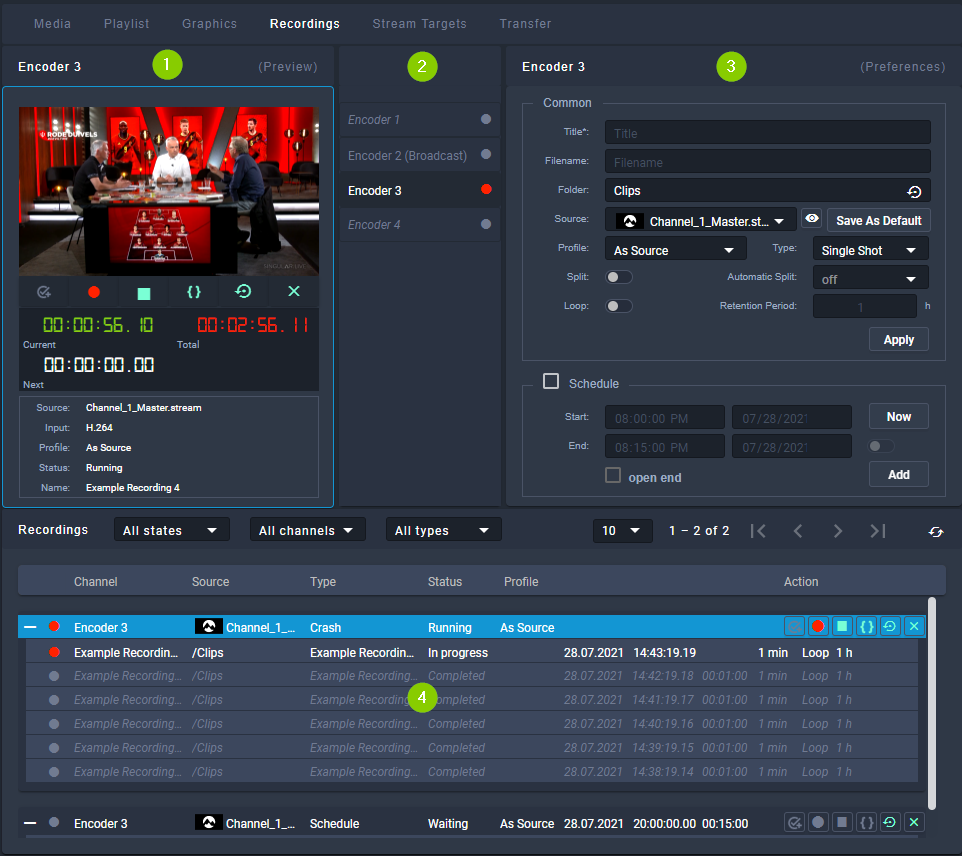 Figure: Makalu Automation - Recordings
Figure: Makalu Automation - Recordings
In the Recordings tab you can record available (live) sources by using available encoders. For more information about how to create recordings, see section Recording.
The tab contains the following areas:
-
Preview - Preview and controls of the currently selected encoder
-
Encoder list - List of available encoders
-
Preferences - Preferences for creating a new recording job for the currently selected encoder
-
Recordings - List of existing recording jobs
The Preview area provides the following controls and information:
In the Encoder list area all available encoders are listed. Depending on their current status, encoders are highlighted in one of the following colors:
- Gray: Encoder is offline or has no active recording jobs
- Green: A recording job is currently prepared
- Red: A recording job is currently running
The Preferences area provides the following input options:
| Name | Description |
|---|---|
| Title | Title of the recording job |
| Filename | Name of the file to be recorded (if no file name is provided, the title is used as file name) |
| Folder | Destination folder where to store the recorded file |
| Source | Source stream to be recorded |
| Save As Default | Set the currently selected source as default for the currently selected encoder |
| Profile | Format/recording profile of the file to be recorded |
| Type | Recording job type, available options:
|
| Split | If enabled, a recorded file can be split either manually via the corresponding control or automatically based on the "Automatic Split" time setting |
| Automatic Split | Time interval for automatically splitting a recorded file (only available if "Split" is enabled) |
| Loop | Enable to enable the retention period field |
| Retention period | Select a duration (in hours) when a recorded file is automatically deleted |
| Apply | Create a recording job with the current settings |
| Schedule | Activate the checkbox to create a scheduled recording job |
| Start | Start time of the scheduled recording job |
| End | End time of the scheduled recording job |
| Now | Set start time to current time and end time to current time plus one hour |
| Add | Create a scheduled recording job with the current settings |
| Duration | Duration of the scheduled recording job (only available if "Schedule" and the toggle switch next to "End" are enabled) |
| Open end | Activate the checkbox to create a scheduled recording job without specifying an end time (the recording job must be stopped manually) |
The Recordings list contains all current recording jobs and the following information:
| Column | Description |
|---|---|
| Channel | Recording channel/encoder used for the recording |
| Source | Recorded source |
| Type | Type of the recording job, available options:
|
| Status | Status of the recording job, available states:
|
| Profile | Format/recording profile of the recorded file |
| Action | The action column provides the following controls:
|
Stream targets¶
Figure: Makalu Automation - Stream targets
The Stream Targets tab lists existing streaming jobs/events. It also allows you to create new streaming jobs/events and to trigger them manually.
The list of Predefined Targets contains all available stream targets and the following information:
The Joblist contains all scheduled streaming jobs/events of the current channel and the following information:
| Column | Description |
|---|---|
| Platform | Icon representing the target platform/type of the job |
| Event | Event title or category |
| Target Name | Name of the stream target |
| Account | Internal name of the corresponding target platform-specific account to be used by the stream target (if applicable) |
| Source | Name of the source stream |
| Scheduled | Scheduled start time |
| Status | Streaming event status, available states:
|
| Edit | Edit metadata of the stream job |
| Link | |
| Action | Actions for manually controlling the streaming job, available actions:
|
Notice
You can only trigger actions that are highlighted with a white or green icon. Actions with a gray icon are not available.
For more information about streaming, see the Streaming section.
Transfer¶
In the Transfer tab all file transfers from ingest storage to playout instances are listed, that are currently running or were recently finished.
Figure: Makalu Automation - File transfer list
The number in brackets beside the playout instance name indicates how many file transfers are currently running. The columns of the list provide details about each file and the transfer progress.
The action column provides the following elements:
| Icon/Element | Description |
|---|---|
 | Pause file transfer |
 | Cancel file transfer |
 | Retry/re-trigger file transfer |
Below the transfer list in the Disk space area the available storage space of the selected playout instance is displayed.
At the bottom of the Transfer tab the media asset list is displayed. This is the same list and provides the same functionality as in the Media tab. For information about how to trigger a file transfer, see section File transfer.
Asset Uploader¶
The Asset Uploader tab integrates the functionality of the Asset Uploader into the Makalu Automation user interface.
Figure: Makalu Automation - Asset Uploader
For information about how to use the Asset Uploader see section Ingest.
Playlist Import¶
The Playlist Import tab enables you to import playlists from third-party traffic systems.
Figure: Makalu Automation - Playlist import
The list of imported playlists provides the following information:
| Column | Description |
|---|---|
| Title | Name/title of the playlist |
| Missing Files | For each imported playlist a missing file list is created. This list includes all files that are used in the imported playlist but are not yet available on the ingest storage. Missing file lists can also be exported. For more information see section Exporting a missing file list. |
| Revision | Playlist revision number (each time a playlist with the same name/title is imported, the revision number is increased) |
| Channel | Target channel |
| Process | Progress/status of the playlist processing/import |
| Import | Button for starting the playlist import. For more information see section Importing a playlist. |
Previewing file-based and live media¶
To preview media, proceed as follows:
-
On the right side, select the Media tab.
-
In the media list select the media type (live or clips).
-
(Optional) To filter the displayed media files, either use the Search field (to filter by file name) or the dropdown menus (to filter by modification date or by resolution).
The media list is filtered based on your filter settings.
-
To preview a file, click the Play icon at the right side of the corresponding list item or drag the item onto the preview player.
The file is loaded by the preview player.
Figure: Makalu Automation - File preview
-
Use the preview player controls to play the file.
Notice
If you preview a live source:
- the player controls are disabled, except the stop button
- you can copy the stream URL to the clipboard by clicking the corresponding Path icon in the Common metadata section
Rundown operating modes¶
Makalu Automation provides the following rundown operating modes:
- manual
- automatic
Manual mode provides full manual control over the rundown. You must add and delete playlists manually as well as triggering cue and play for clips.
Automatic mode automates adding playlists to the rundown and triggering cue and play. Playlists created with a future start time in Makalu Traffic are automatically added to the rundown. The first clip of the playlist is automatically cued. When the start time is reached, play is automatically triggered. When the playlist is finished, it is automatically removed from the rundown (depending on how the playlist properties "Protected" and "Do not use" are set).
Notice
The time intervals that are used to select which playlist should automatically be added or removed from the rundown can be configured via pre roll and post roll settings. Both intervals are usually set between 4 to 8 hours.
To change the rundown operating mode, use the Operational mode toggle switch in the toolbar at the top of the rundown. If the switch is activated, manual mode is enabled. If the switch is deactivated, automatic mode is enabled.
Figure: Makalu Automation - Rundown operating mode toggle switch
Adding elements to a rundown¶
Adding a playlist to a rundown¶
To add a playlist to a rundown, proceed as follows:
-
On the right side, select the Playlist tab.
All available playlists for the current channel are listed.
Figure: Makalu Automation - Available playlists
-
To add a playlist to a rundown, you can either:
-
drag a playlist and drop it onto the DropZone area on the bottom left, or
-
select a playlist by clicking the corresponding row in the Playlist tab (the row will be highlighted in blue) and click the Plus icon (Add playlist to rundown) at the top right.
Figure: Makalu Automation - Adding a playlist to the rundown
The playlist is added to the rundown as last element and the start date/time are dynamically calculated without creating gaps.
Figure: Makalu Automation - Playlist added to the rundown
Tip
To add a playlist to a rundown at a specified start date/time, activate the checkbox in the Sched (Scheduled) column before you drag the playlist onto the DropZone area or click the Add playlist to rundown button.
If the playlist already has a specified start date/time, this will be applied. If the playlist has no specified start date/time, a dialog is displayed where you can select the start date/time.
Notice
You cannot add a playlist with a specific scheduled start date/time to a rundown if there is already a playlist in the rundown scheduled for the same date/time.
Notice
Playlists with a fixed start date/time can only be added to a rundown if the start date/time is in the future.
Notice
If the added playlist includes files that are not available on the channel's playout instances, file transfers are automatically started. As a result all corresponding files are copied from the ingest storage to all playout instances that are assigned to the channel. See section File transfer for more information.
-
Adding media to a rundown¶
In addition to playlists you can also add media assets (video files, secondary events, live sources, or placeholders) to a rundown, by adding them to a show in a playlist.
Notice
If you want to add a video file to a rundown, its resolution and framerate should usually match the channel output properties exactly. For example, if you use a channel that is configured to 1080p and 25 fps output, you should use files with a resolution of 1920x1080 px and a framerate of 25 fps.
Video files with properties that differ from the current channel output properties are highlighted in the media list (the resolution and/or the framerate are highlighted in red):
Figure: Makalu Automation - Video files with resolutions and framerates that do not match the channel output properties
By default, you cannot add video files that use other resolutions or framerates than the current channel properties Depending on the channel configuration it may be possible to add files to a rundown, that do not match the channel properties.
To do this, proceed as follows:
-
In the rundown select the playlist to which you want to add media.
The playlist is expanded, and all included shows are listed.
-
On the right side, either select the Home or Media tab.
All available media is listed in the media list.
Figure: Makalu Automation - Playlist expanded, and home tab opened
-
Select one or more video files, live sources, or placeholders from the media list on the right side and drop them onto a show in a playlist in the rundown on the left side.
Figure: Makalu Automation - Adding video files to a show
The selected video file, live source, or placeholder is added to the rundown as last clip of the selected show.
Figure: Makalu Automation - Video files added to a show
Tip
Instead of adding a clip at the end of a show you can also replace an individual clip in a show by dragging and dropping the new media asset directly on the clip to be replaced while holding [Shift]. In this case a confirmation dialog is displayed that also informs you if the rundown duration will be shortened or extended by this replacement. For more information see section Replacing a clip.
Notice
If the added file is not available on the channel's playout instances, file transfers are automatically started. As a result the corresponding file is copied from the ingest storage to all playout instances that are assigned to the channel.
-
(Optional) Change the show’s clip list order to move the added clip to a specific position within the selected show.
Adding trimmed media to a rundown¶
To add only a specific subsection of a video file to a rundown, proceed as follows:
Notice
Trimming is only possible for media assets that represent actual video files. In the media list these files are usually listed under Clips in the folder tree. Live and placeholder media assets cannot be trimmed.
-
In the rundown select the playlist to which you want to add trimmed media.
The playlist is expanded, and all included shows are listed.
-
On the right side, select the Media tab.
All available media is listed in the media list.
-
In the media list select the media asset to be trimmed and click the Play icon on the right side.
Tip
You can also open a media asset in the preview player by dragging it from the media list and dropping it onto the preview player.
The media asset is opened in the preview player.
-
Use the preview player controls to select the timecode for the mark in.
-
To set the selected timecode as mark in, click the Set Mark In
 icon.
icon.Figure: Makalu Automation - Trimmed media - Mark in set
-
Use the preview player controls to select the timecode for the mark out.
-
To set the selected timecode as mark out, click the Set Mark Out
 icon.
icon.Figure: Makalu Automation - Trimmed media - Mark out set
-
Use the draggable element below the preview player (consisting of thumbnail and file name, located between "Position", and "Remaining") and drag it onto the show to which you want to add it.
Figure: Makalu Automation - Adding trimmed media to a show
The selected video file is added to the rundown as last clip of the selected show.
Figure: Makalu Automation - Trimmed media added to a show
Tip
Instead of adding a trimmed clip at the end of a show you can also replace an individual clip in a show by dropping the draggable element directly on the clip to be replaced while holding [Shift]. In this case a confirmation dialog is displayed that also informs you if the rundown duration will be shortened or extended by this replacement. For more information see section Replacing a clip.
Notice
Trimmed files in the rundown are recognizable by their color. The scheduled duration (displayed in the "Scheduled dur" column) of trimmed files is highlighted in yellow.
Notice
If the added file is not available on the channel's playout instances, file transfers are automatically started. As a result the corresponding file is copied from the ingest storage to all playout instances that are assigned to the channel.
-
(Optional) Change the show’s clip list order to move the added clip to a specific position within the selected show.
Adding secondary events to a rundown¶
To add a secondary event to a rundown, proceed as follows:
Notice
Secondary events can only be added to clips.
-
In the rundown select the show that includes the clip to which you want to assign the secondary event.
The show is expanded, and all included clips are listed.
-
On the right side, select the Home or Media tab.
All available media is listed in the media list.
Figure: Makalu Automation - Show expanded, and media tab opened
-
In the media list click Secondary Events and select the type of secondary event you want to add.
-
Select one or more secondary events and drag them onto a clip in the rundown.
Figure: Makalu Automation - Secondary event selected
The selected secondary event is added to the clip.
Figure: Makalu Automation - Secondary event added to a clip
Editing the rundown¶
Editing the start time or duration of a clip¶
To edit the start time of a clip, proceed as follows:
Notice
You can only edit the start time of a clip if the clip is not currently on air.
-
In the rundown click on a playlist to expand it.
-
Click on a show in the selected playlist to expand it.
-
To edit the scheduled start time of a clip, click on the Scheduled Time field of the corresponding clip.
Figure: Makalu Automation - Editing a clip start time
A dialog is displayed where you can enter the start date and time.
Figure: Makalu Automation - Entering a clip start time
-
Enter the start date and time (format
hh:mm:ss:ff).Notice
You can only enter a start time that lies in the future.
-
To confirm the new value, click Apply.
The edited scheduled start time is applied and highlighted in green.
Figure: Makalu Automation - Scheduled clip start time edited
Notice
If you change the scheduled start time of a clip, the scheduled start times of all following clips are updated accordingly.
To edit the duration of a clip, proceed as follows:
-
To edit the duration of a clip, in the selected show, click on the Scheduled Dur (Duration) field to be edited.
A dialog is displayed where you can enter the duration.
-
Enter the new duration (format
hh:mm:ss:ff).Notice
If you enter a scheduled duration that is longer than the original duration, the clip playback is looped. When the original duration ends, the clip playback starts from the beginning and plays until the entered scheduled duration is reached.
If you enter a scheduled duration that is shorter than the original duration, the clip playback stops when the entered scheduled duration is reached.
-
To confirm the new value, click Apply.
The edited duration is highlighted in yellow.
Editing the start time or duration of a secondary event¶
To edit the start time or duration of a secondary event, proceed as follows:
-
In the rundown click on a playlist to expand it.
-
Click on a show in the selected playlist to expand it.
-
Click on a clip that has an assigned secondary event (which is recognizable by a plus icon on the left side) to expand it.
-
Depending on what property you want to edit, either click on the Start-Offset or Duration field of the corresponding secondary event.
Edit the start-offset of a secondary event
-
Enter the new duration (format
hh:mm:ss:ff). -
Press [Enter].
The entered value is applied.
Start-offset of a secondary event edited
Using groups¶
The group feature allows you to assign multiple clips within a show to a group. Each group is highlighted in a different color to facilitate the differentiation of groups.
Tip
You can play a group of clips in a loop, by activating the loop flag for the last clip in a group. When the playback of the last clip in the group is finished, the playback of the first clip in the group starts again.
To add clips to a group, proceed as follows:
-
In the rundown click on a playlist to expand it.
-
Click on a show in the selected playlist to expand it.
-
In the selected show, select multiple consecutive clips to be grouped.
-
In the top right corner of the rundown, click the Create group
 icon.
icon.Figure: Makalu Automation - Rundown - Create group
The selected clips are assigned to a new group and are highlighted in the same color (orange in the example below).
Figure: Makalu Automation - Rundown - Group created
To remove clips from a group, proceed as follows:
-
In the rundown click on a playlist to expand it.
-
Click on a show in the selected playlist to expand it.
-
In the selected show, select the clips to be removed from the group.
-
In the top right corner of the rundown, click the Delete group
 icon.
icon.Figure: Makalu Automation - Remove clips from group
The selected clips are removed from the group. If all clips are removed from a group, the group is removed.
Figure: Makalu Automation - Clips removed from group
Moving clips¶
To change the clip order in a show, proceed as follows:
-
In the rundown click on a playlist to expand it.
-
Click on a show in the selected playlist to expand it.
-
In the selected show, select one or more clips to be moved.
-
Depending on where you want to move the clips, select the corresponding function:
-
To move the clips one position up in the list, click the
 File up icon.
File up icon. -
To move the clips one position down in the list, click the
 File down icon.
File down icon. -
To move the clips to the beginning of the selected show’s clip list, click the
 First file icon.
First file icon. -
To move the clips to the end of the selected show’s clip list, click the
 Last file icon.
Last file icon.The clips are moved to the selected position.
-
Replacing a clip¶
Notice
This function must be used to replace virtual placeholder assets with other media assets that represent actual video files. In addition it can be used to replace any clip in the rundown (regardless of the type) with any other available media asset (regardless of the type).
To replace a clip in a rundown, proceed as follows:
-
In the rundown click on a playlist to expand it.
-
Click on a show in the selected playlist to expand it.
-
On the right side select the Home or Media tab.
-
In the media list select the type of the media asset (video file, live source, or placeholder).
-
Hold [Shift] and drag an item from the media list on the right side and drop it onto the clip to be replaced in the rundown on the left side.
Figure: Makalu Automation - Replace clip
A confirmation dialog is displayed that also informs you if the rundown duration will be shortened or extended by this replacement.
-
To confirm the replacement, click Yes in the confirmation dialog.
Notice
If the new item is a live source, you additionally must select the duration of the live clip and click Apply.
The original rundown item is replaced by the new item.
Figure: Makalu Automation - Clip replaced
Notice
If the new file is not available on the channel's playout instances, file transfers are automatically started. As a result the corresponding file is copied from the ingest storage to all playout instances that are assigned to the channel.
Assigning or deleting a default graphic¶
To assign a default graphic to a playlist, show, or clip, proceed as follows:
-
In the rundown select a playlist, show, or clip.
-
Click the Add default graphic
 icon.
icon.Figure: Makalu Automation - Assign default graphic
The default graphic is assigned to the selected element(s), which is recognizable by the corresponding icon in the SE (Secondary events) column.
Figure: Makalu Automation - Default graphic assigned
To delete a default graphic from a playlist, show, or clip, proceed as follows:
-
In the rundown select a playlist, show, or clip.
-
Click the Delete default graphic
 icon.
icon.Figure: Makalu Automation - Delete default graphic
The default graphic is deleted from the selected element(s).
Figure: Makalu Automation - Default graphic deleted
Adding or deleting a splicing event¶
For information about how to use splicing events, see section Ad triggering:
Deleting a clip or a playlist¶
Notice
You can only delete a clip if it is in status Ready or if it is a placeholder. You cannot delete a clip if it is cued or on air.
The same applies to playlists. You can only delete a playlist if no clip in the playlist is cued or on air.
To delete a clip from the rundown, proceed as follows:
-
Select the clip to be deleted and in the toolbar at the top of the rundown click the Delete
 icon.
icon.Figure: Makalu Automation - Delete a clip
-
Confirm the displayed dialog by clicking Yes.
The clip is deleted.
To delete a playlist from the rundown, proceed as follows:
-
Select the playlist to be deleted and in the toolbar at the top of the rundown click the Delete
 icon.
icon.Figure: Makalu Automation - Delete a playlist
-
Confirm the displayed dialog by clicking Yes.
The playlist is deleted.
Deleting a fix start time¶
To delete a fix start time from an element in a rundown, proceed as follows:
-
In the rundown either select a playlist, show, or clip with a fixed start time.
-
Click the Delete fix start time
 icon.
icon.Figure: Makalu Automation - Delete fix start time
The fix start time is removed from the selected element.
Reloading the rundown¶
Notice
Manually reloading the rundown is only necessary in case of an error, e.g. if the clip status is displayed as “Unknown”.
To manually reload the rundown, click the ![]() Reload rundown icon in the top left corner of the rundown.
Reload rundown icon in the top left corner of the rundown.
Controlling the rundown playback¶
The rundown playback can either be triggered automatically (based on the scheduled playlist start time) or manually by using the rundown control either below the channel preview or via the big buttons at the bottom left of the screen.
To manually start the playback, proceed as follows:
-
In the rundown cue a clip to prepare it for playback, by either:
-
clicking the Cue next clip/Cue next icon in the rundown control, or
-
by clicking on the clip status of a clip that is in "Ready" status.
Notice
If you use the first method, this either cues the first clip in the rundown (if previously no clip was cued) or the next clip after the previously cued clip.
Figure: Makalu Automation - Cueing a clip
The clips status changes to "Cue".
Figure: Makalu Automation - Cued clip
-
-
To start playback, click the Next / Take next icon.
Figure: Makalu Automation - Playing a clip
The clip is played. The clips status changes to "On Air".
Figure: Makalu Automation - Clip is playing
-
To manually stop playback, click the Stop icon.
-
Confirm the confirmation dialog by clicking Yes.
The playback is stopped. The clips status changes to "Ready".
Figure: Makalu Automation - Playback stopped
Notice
If you manually stop playback, the previously cued clip remains cued. To completely reset the player and clip status (setting all available clips to status "Ready"), click the Eject player icon
 below the channel preview and confirm the following dialog by clicking Yes.
below the channel preview and confirm the following dialog by clicking Yes.
File transfer¶
As described in section Ingest, all files are initially uploaded to the ingest storage. Afterwards each file, that is used in a rundown, must be copied to all playout instances (e.g. main and backup playout instance) that are assigned to the corresponding channel. The file transfer between ingest and playout storage can be triggered in the following ways:
- add a new playlist to the rundown, which automatically triggers transfers for all used files that are not yet available on the playout instances
- add a file to an existing show in a playlist in the rundown, which automatically triggers transfers for all used files that are not yet available on the playout instances
- trigger a file transfer manually via the media asset list (either via the Media tab or Transfer tab)
The file transfer status (that indicates if a file is already available on all related playout instances) is recognizable by colored bars in the media asset list:
Figure: Makalu Automation - File transfer status
 Green bar - the file transfer is completed, the file is already available on the playout instances
Green bar - the file transfer is completed, the file is already available on the playout instances Black bar - the file is not available on the playout instances
Black bar - the file is not available on the playout instances
A list of all currently running and recent file transfers is available in the Transfer tab.
Notice
The number of file transfers running at the same time is configurable and by default set to 5 parallel file transfers.
Triggering a file transfer manually¶
To trigger a file transfer from ingest storage to playout instances manually, proceed as follows:
-
Select the Media tab or the Transfer tab.
-
In the Source dropdown menu select the ingest storage (e.g. "Playoutdata").
-
Select a folder that contains files that are not available on playout instances (indicated by a black bar to the left of the file import date).
-
Select one or more files to be transferred.
-
In the toolbar at the top right of the media asset list click the Upload assets icon
 .
.Figure: Makalu Automation - Start file transfer
-
Confirm the dialog by clicking Yes.
The transfer of the selected file(s) starts.
-
Select the Transfer tab to view the file transfer progress.
Figure: Makalu Automation - File transfer started
The file transfer to the playout instances is completed. This is also indicated by a green bar to the left of the file import date.
Figure: Makalu Automation - File transfer completed
Deleting transferred files manually¶
Notice
You can only delete files from a playout instance, that are not currently used in the rundown.
To manually delete files from a playout instance, proceed as follows:
-
Select the Media tab or the Transfer tab.
-
In the Source dropdown menu select the playout instance (e.g. "Player_Master").
-
Select the folder that contains the files to be deleted.
-
Select one or more files to be deleted.
-
In the toolbar at the top right of the media asset list click the Delete assets icon
 .
.Figure: Makalu Automation - Delete files
-
Confirm the dialog by clicking Yes.
The selected files are deleted from the playout instance storage. This is also indicated by a black bar to the left of the file import date.
Importing a playlist¶
Notice
Makalu supports the import of XML-based playlists. For further information please contact [email protected].
To import a playlist, proceed as follows:
-
Select the Playlist Import tab.
-
To add a playlist, either:
-
drag the playlist file on the drop zone area, or
-
click select and select the playlist file.
-
-
Select the target channel to which the playlist should be assigned.
-
To confirm your selection, click Apply.
-
Click Process.
The content of the playlist file is checked and processed.
-
Click Import.
The playlist is imported.
Exporting a missing file list¶
To export a missing file list, proceed as follows:
-
Select the Playlist Import tab.
-
Click the plus icon of an imported playlist that has missing files.
The missing file list expands, and all missing files are listed.
-
Click Export.
The missing file list is downloaded.
Notice
Missing file lists are exported as CSV files.
Restarting the player¶
Warning
Use the channel restart trigger only in case of an emergency (e.g. if a player error occurs).
Restarting the player takes a short amount of time. During this time no output signal is generated.
To manually restart the player, proceed as follows:
